
Когда выходишь на берега реки Тверцы в Торжке, то первым делом бросается в глаза большое количество церквей. Куда ни глянь – везде купола и главки. Где-то маленькие и стройные...
 Маковки Георгиевской церкви. Вид с валов Новоторжского кремля
Маковки Георгиевской церкви. Вид с валов Новоторжского кремля
...где-то огромные и величественные.
 Купола бывшего Вознесенского монастыря
Купола бывшего Вознесенского монастыря
Но, к сожалению, многие без крестов. Это уже наследие советской эпохи. Добротные каменные здания церквей использовались для нужд народного хозяйства. К концу XX столетия хозяйства этого не стало, многие строения пришли в запустение. Что-то удалось вернуть РПЦ. Но часто и это возвращенное оказалось не очень нужным. Будем надеяться, это временные трудности. Ну, а многое так и стоит в запустении, часто в руинах.
 Власьевская церковь. Вроде как, даже начиналась реставрация
Власьевская церковь. Вроде как, даже начиналась реставрация
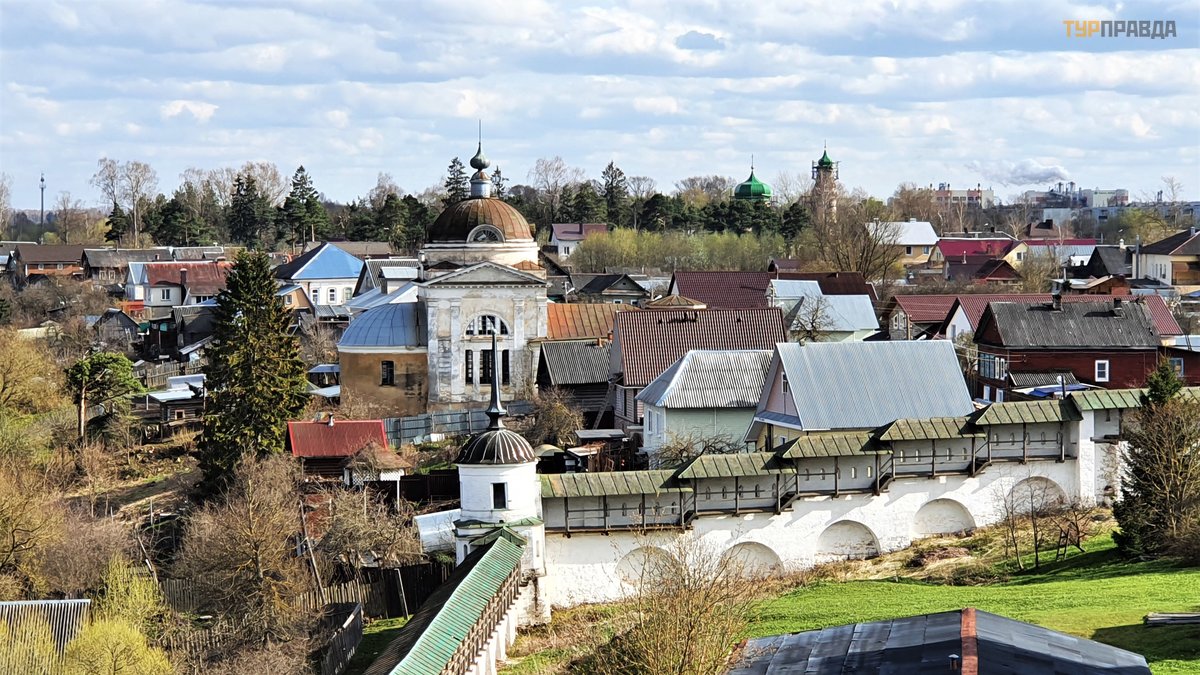 Воскресенская церковь
Воскресенская церковь
Но мой посыл не в критике местных властей и хозяйствующих субъектов. Об этом уже говорено-переговорено, писано-переписано. Я о другом.
Думаю, у многих, собственно, как и у меня, при посещении провинциального Торжка возникал вопрос: откуда в этом крохотном городке такие огромные храмы? Прямо-таки, римские масштабы. Ну, да, великое в малом…
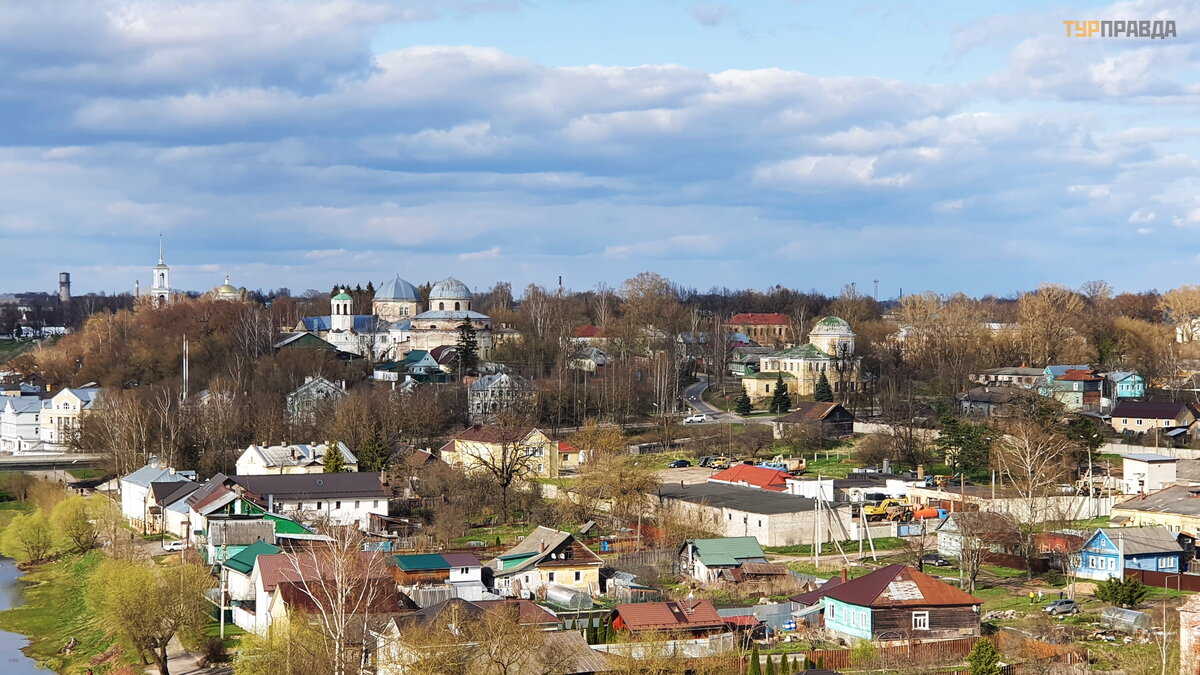
Дело в том, что Торжок далеко не всегда был простецким провинциальным городишком. А сейчас, чего уж там, ну, совсем деревня (без обид), но очень очаровательная.
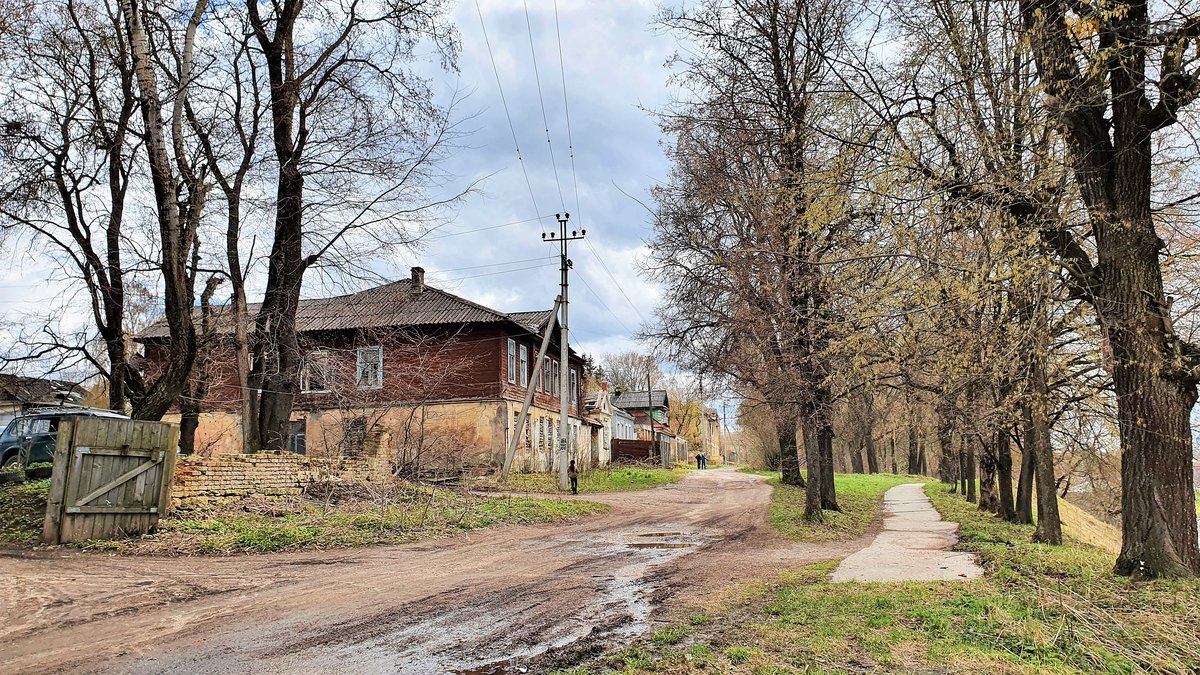 ул. Красная Горка
ул. Красная Горка
Точной даты основания города никто не знает, предположительно рубеж X-XI веков. Он изначально создавался как место торга новгородскими купцами – Новый Торг. Так и слыл на протяжении многих веков богатым торговым городом. Хотя многократно разорялся и Батыем, и поляками, но вновь и вновь возрождался, так как удобно располагался на торговых путях. К XIX веку 70% населения составляли купцы. Богатые люди всячески пытались увековечить свои фамилии. Самым модным, скажем так, в те времена было – это пожертвовать средства на богоугодное дело – строительство храма, например, глядишь, может на том свете и зачтется. К тому же сооружались свои собственные церкви, и чем больше, тем круче, если выразиться на современный лад. Да и не очень богатые горожане посадами и слободами строили храмы, и тоже не прочь были посоперничать друг перед другом богатством форм и убранства своих церквей. Такое дело было, есть и будет. Только каждому времени присущи свои объекты соревнования.
Если интересно, пойдемте взглянем поближе на некоторые храмовые объекты Торжка. Они так и манят своими формами и силуэтами. Я так всеми правдами и неправдами водила свое семейство по городу, лишь бы взглянуть на тууу громадину или вооон ту...
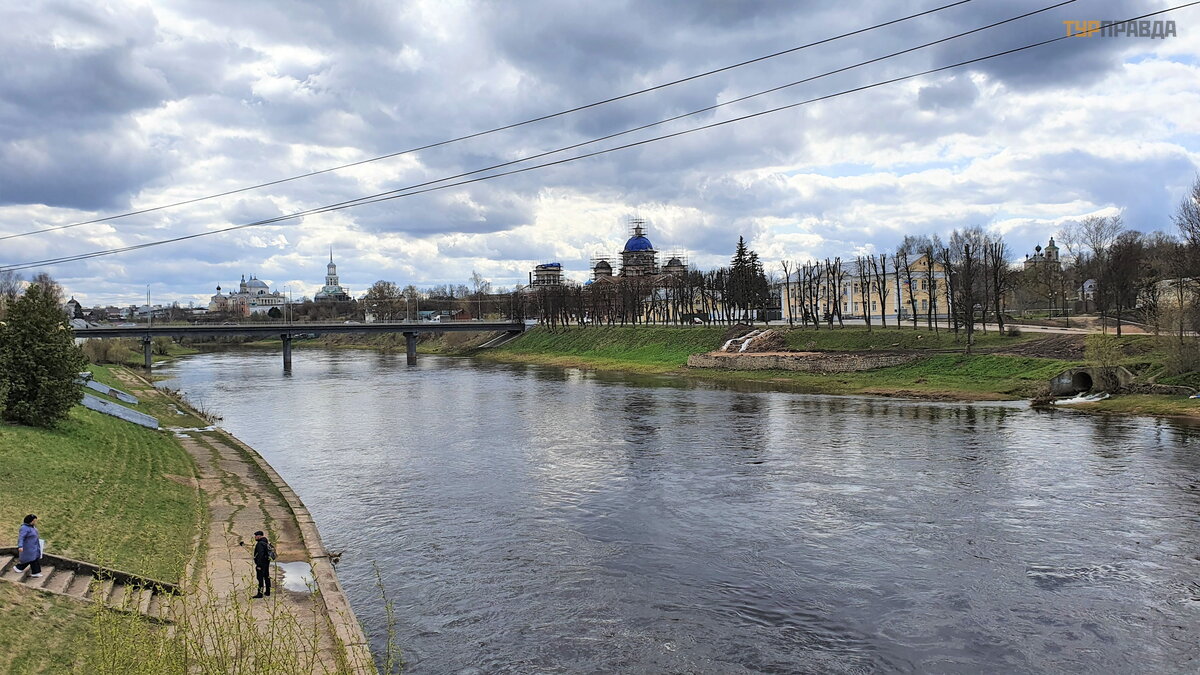
Семейство, в составе папы и двух отпрысков 10-ти и 9-ти лет от роду, делало попытки сопротивления. Не без трудностей, как говорится : ). И сей факт очень напрягает меня в семейных поездках. А что делать, детенышей девать некуда, тоже просвещать надо. Но мы научились находить компромиссы, так что кое-что удалось.
Самой главной точкой притяжения Торжка является Борисоглебский мужской монастырь.
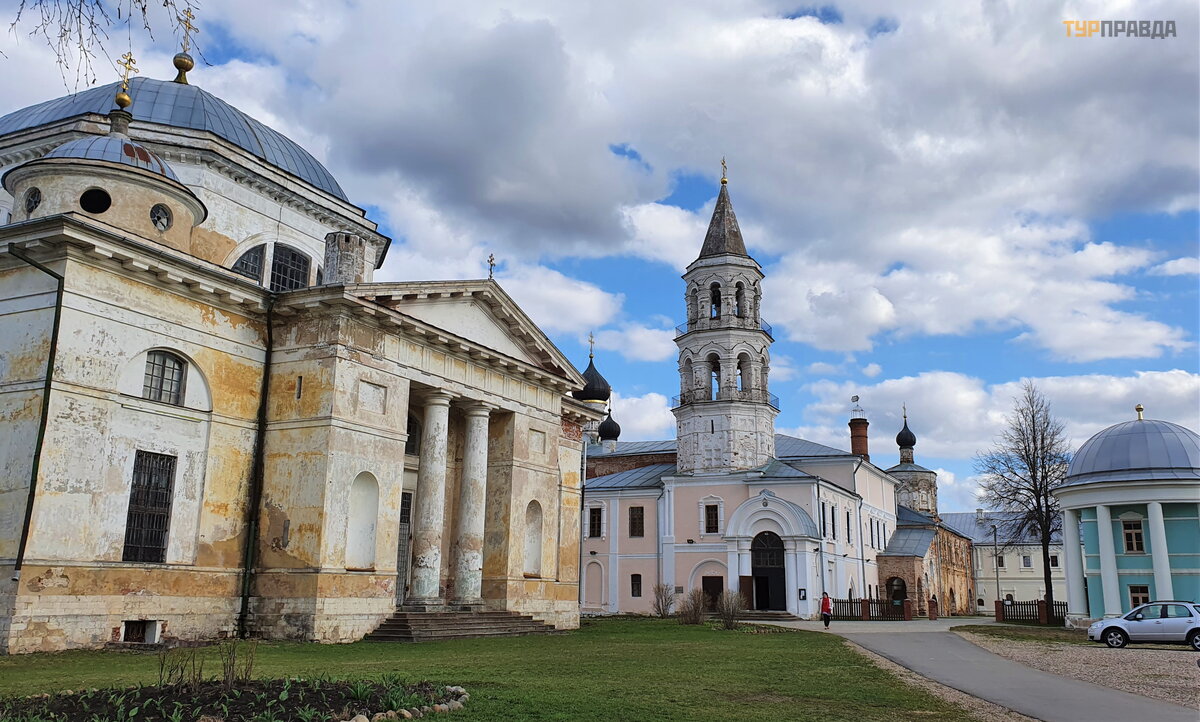
Новоторжский Борисоглебский мужской монастырь – одна из старейших православных обителей на русской земле. Основан был он в 1038 году преподобным Ефремом. Ефрем служил конюхом у братьев княжичей Бориса и Глеба, младших сыновей Владимира Святославича, которых из-за опасений потерять престол и убил родной старший брат князь киевский Святополк. Верный слуга после гибели братьев ушел из мирской жизни и пошел в новгородские земли в поисках тишины и покоя. После долгих странствий и скитаний на высоком холме на берегу реки Тверцы и остался молиться за упокой Бориса и Глеба.
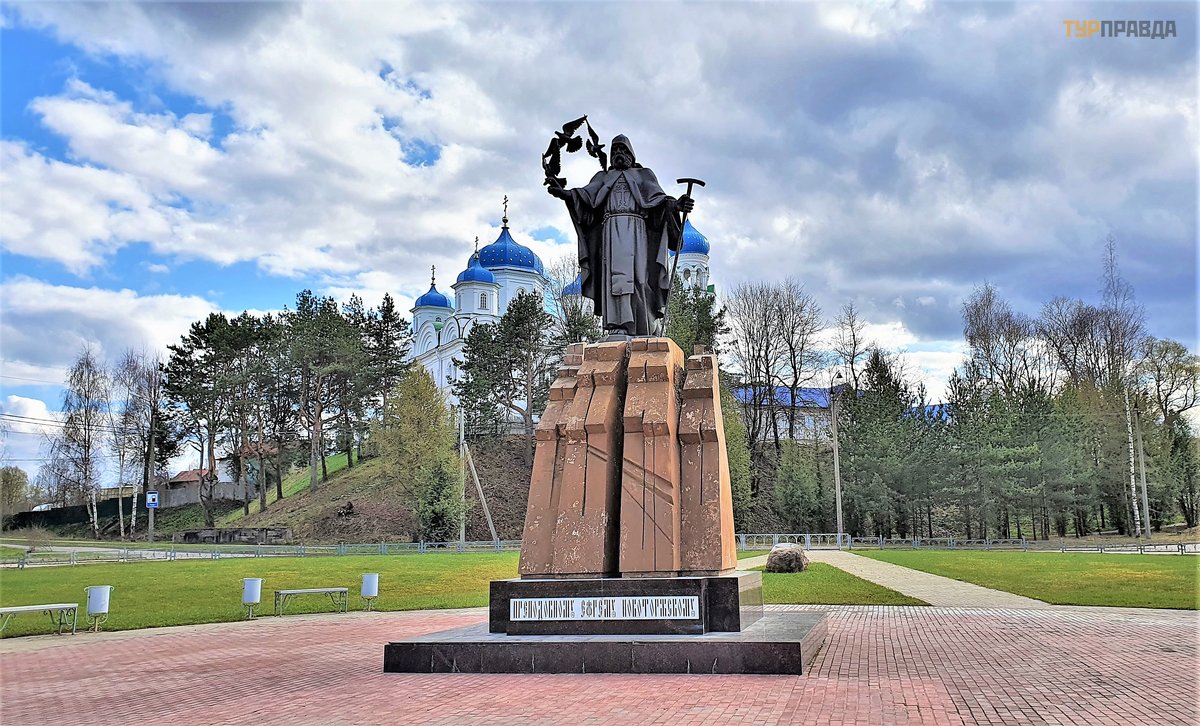 Памятник преподобному Ефрему Новоторжскому. Установлен в 2015 г.
Памятник преподобному Ефрему Новоторжскому. Установлен в 2015 г.
Постепенно обитель разрасталась. А через какое-то время рядом обосновались новгородские купцы, так зародился город Новый Торг, который мы сейчас именуем Торжком. По другой версии Ефрем обосновался на соседнем холме близ уже существовавшего тогда города.
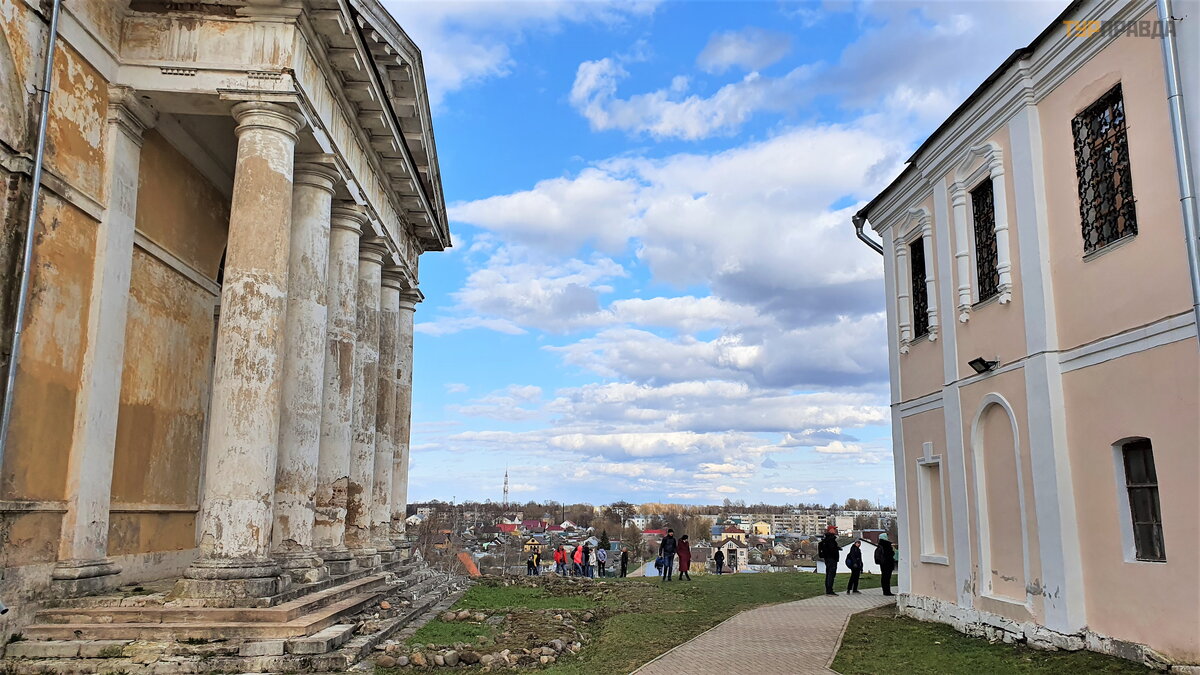
С тех стародавних времен, конечно, уже ничего не сохранилось.
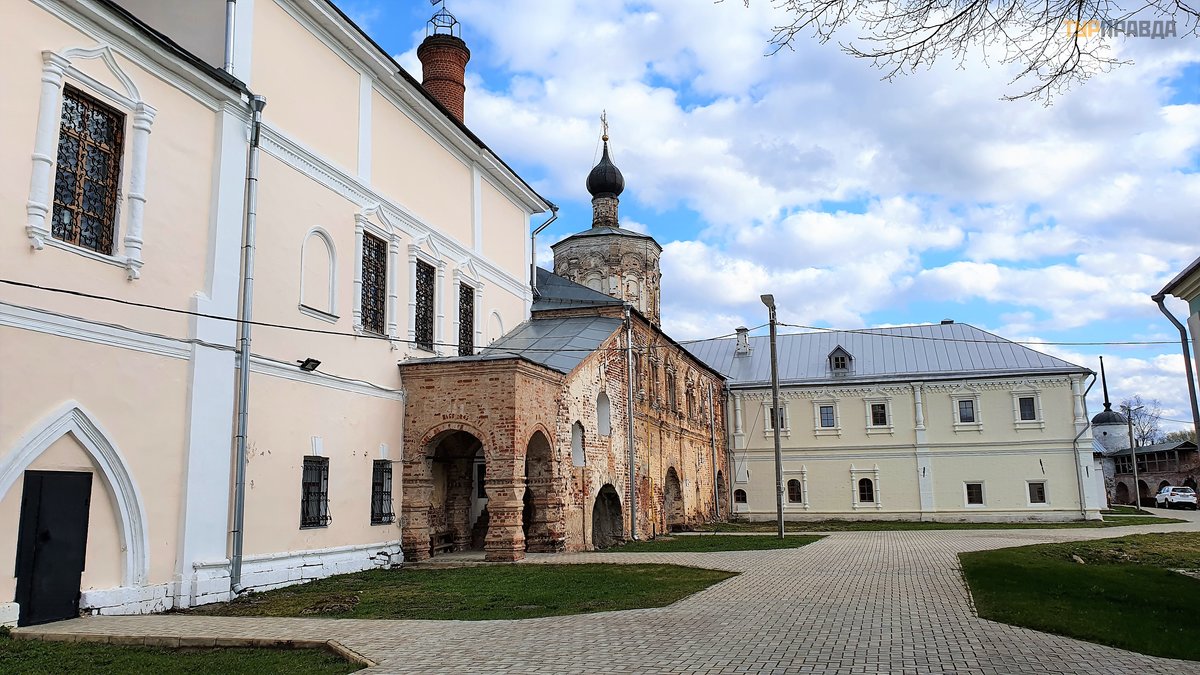 Входоиерусалимская церковь (1717 г. ), настоятельский корпус (1717 г. )
Входоиерусалимская церковь (1717 г. ), настоятельский корпус (1717 г. )
 Монастырская стена (конец XVIII века)
Монастырская стена (конец XVIII века)
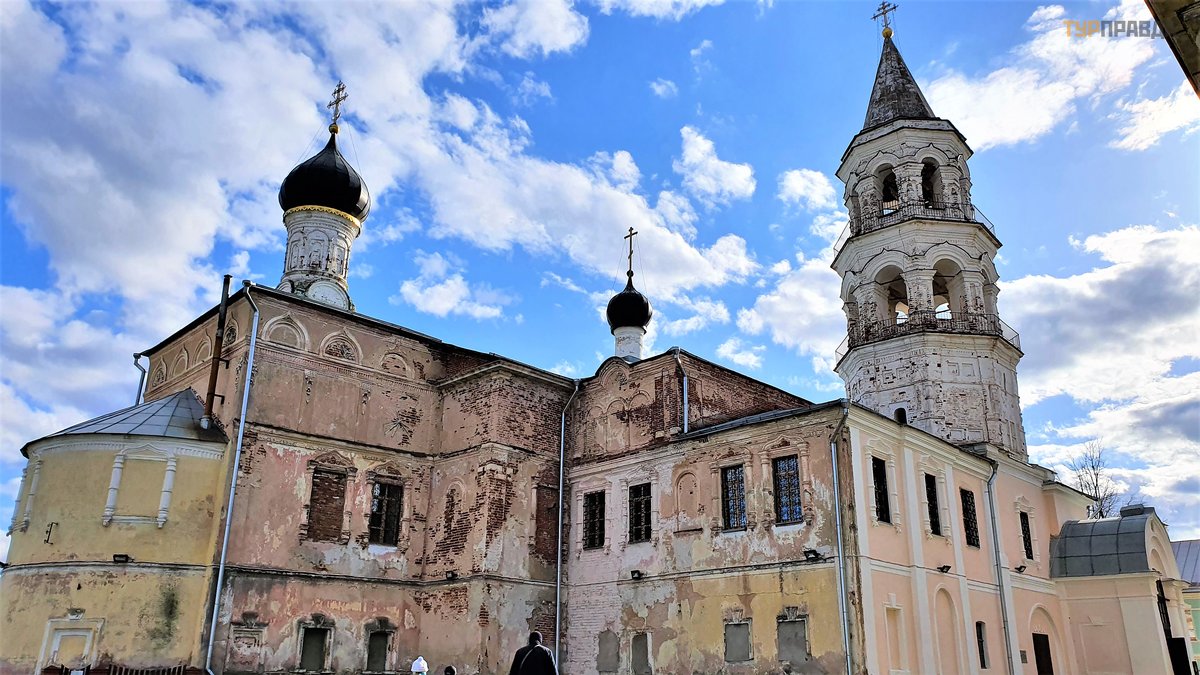 Введенская церковь (1620 г. ) – самое старое сохранившееся здание монастыря
Введенская церковь (1620 г. ) – самое старое сохранившееся здание монастыря
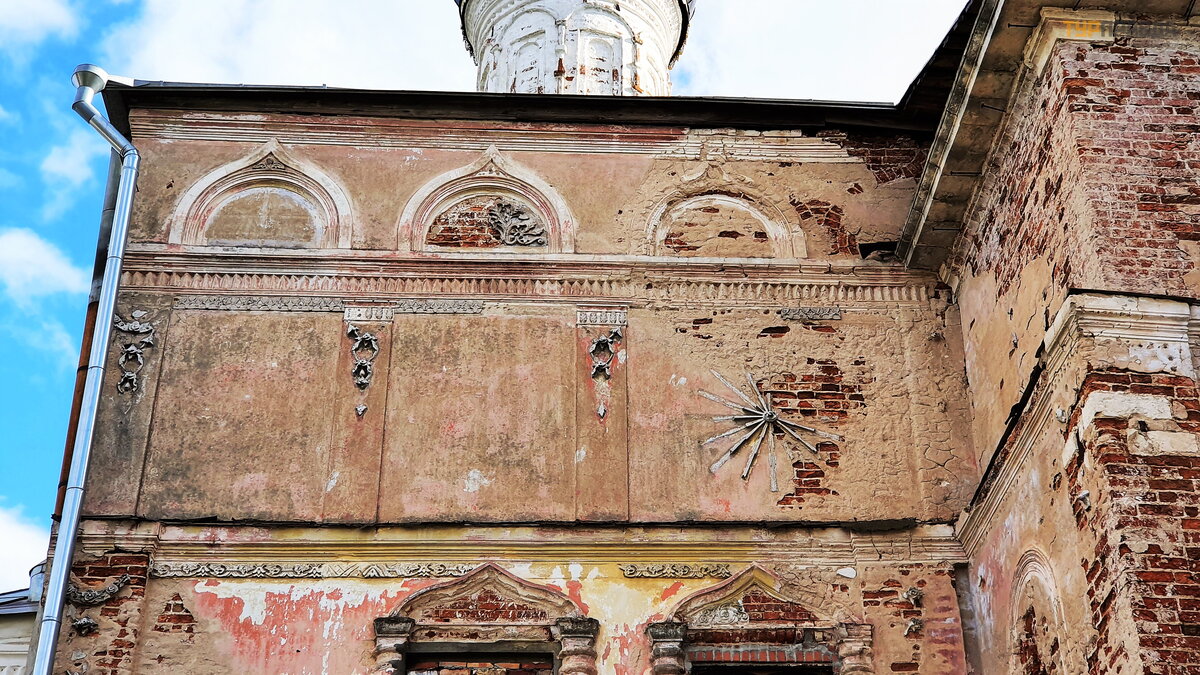
Этому поспособствовали и многочисленные разорения, и, наоборот, богатство и могущество. Да, бывает и так. В XVIII-XIX веках монастырь процветал, и он мог себе позволить перестройку. В результате чего и возводились новые строение взамен старых и ветхих. Архитектурный образ монастыря сформировался к началу XIX века.
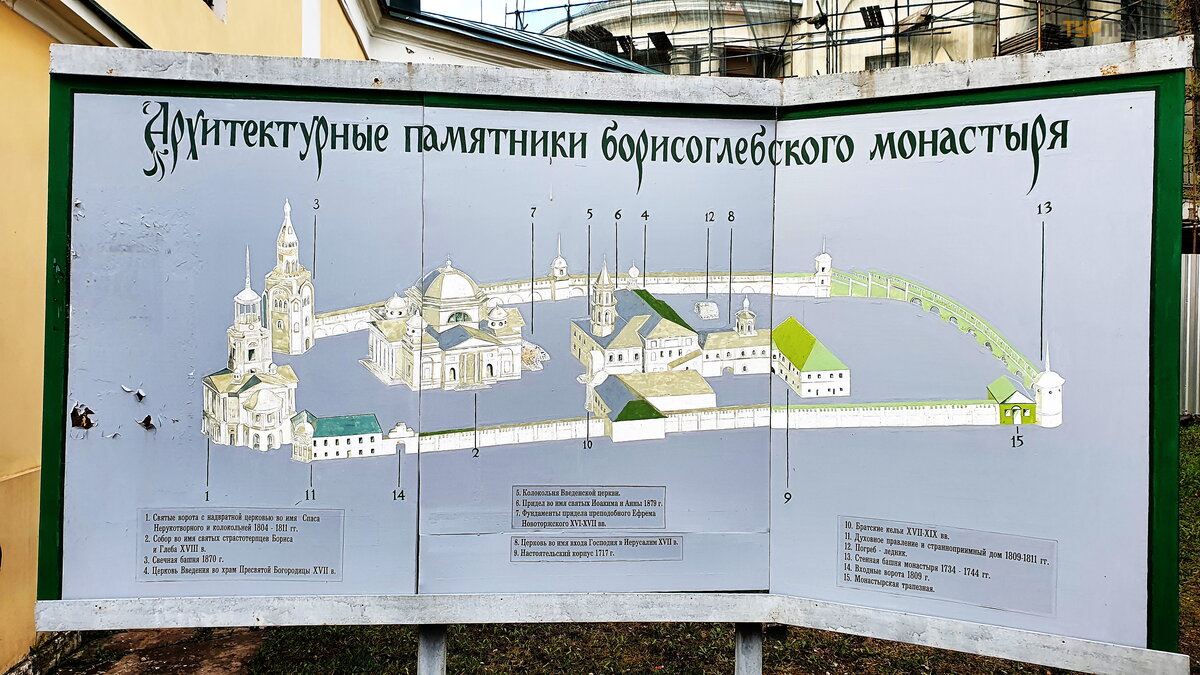
После закрытия в 1925 г. на долгие годы монастырь стал тюрьмой строгого режима, потом там лечили алкоголиков. В конце 80-х гг. прошлого века комплекс был передан в ведение историко-этнографического музея. И вот с этого времени мало-помалу начинается возрождение монастыря. Но все как-то оочень медленно. Видела фото прошлых лет, Борисоглебский собор был в лесах. Леса убрали, собор остался, видимо, в прежнем состоянии.
 Борисоглебский собор (1796 г. )
Борисоглебский собор (1796 г. )
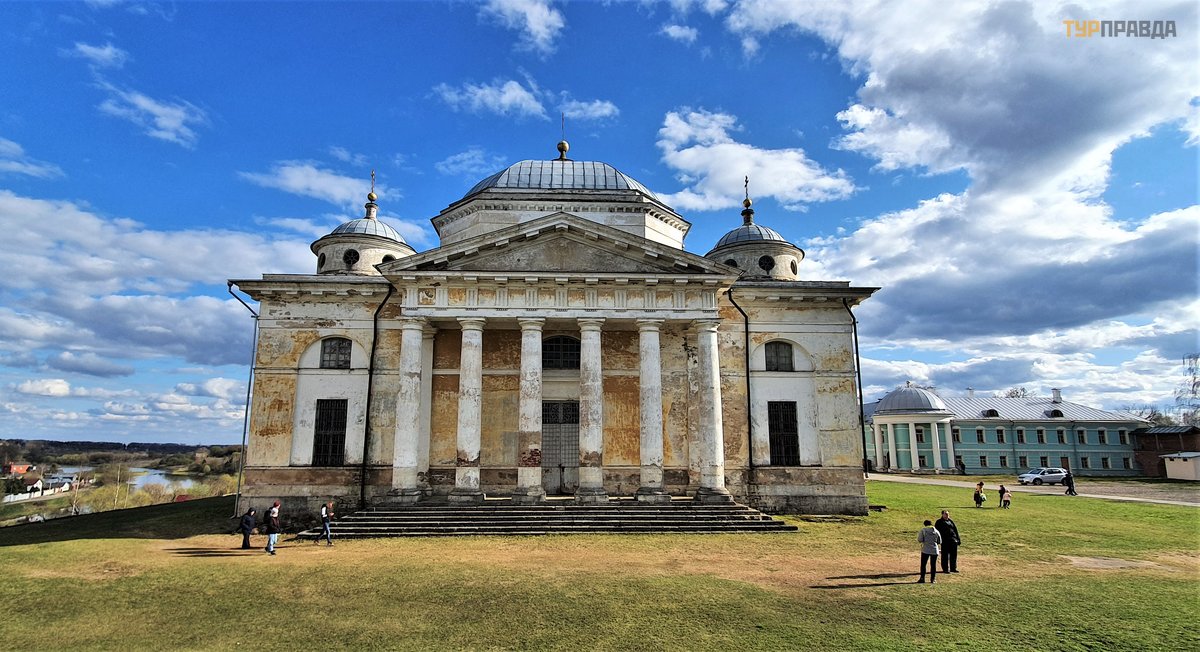 Борисоглебский собор (1796 г. )
Борисоглебский собор (1796 г. )
В настоящий момент Борисоглебский монастырь – это самая яркая достопримечательность города Торжка. Для вездесущих и вселазающих туристов организована смотровая площадка в Свечной башне.
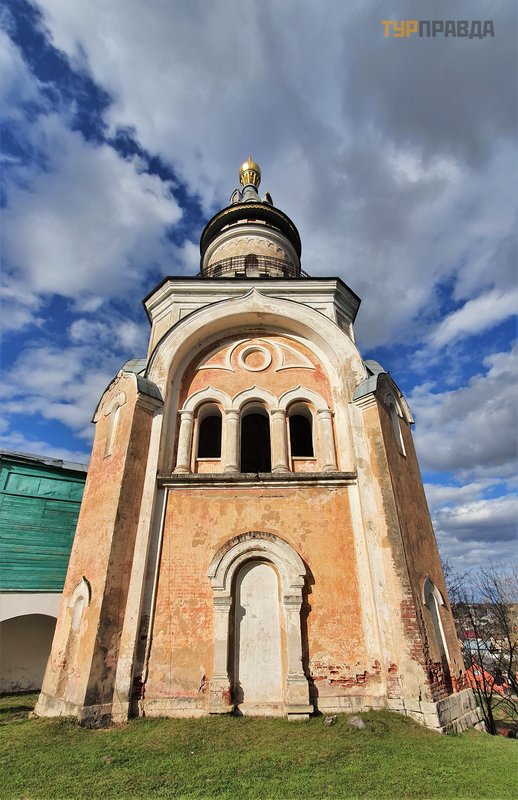 Свечная башня (1809 г. )
Свечная башня (1809 г. )
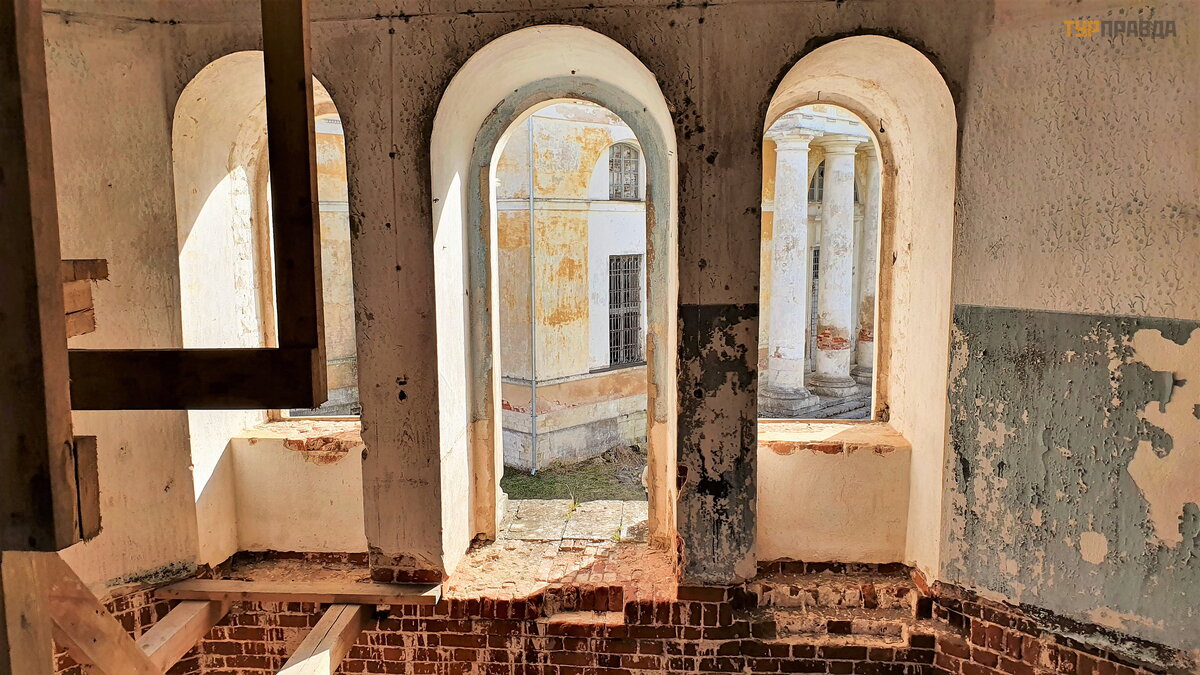
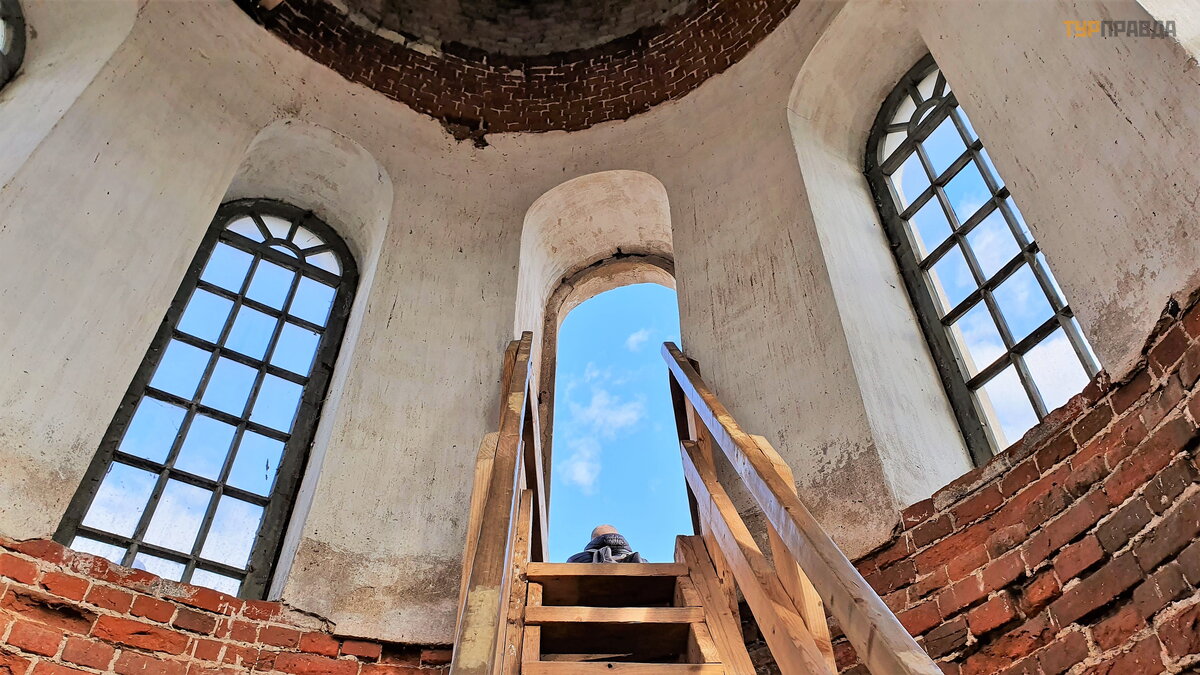
Прознав об этом мероприятии, я очень подгоняла своих спутников, боялась, как бы не припоздниться, так как точного графика работы у меня не было. Очень уж я люблю все эти « смотровые» дела. И вам, при случае рекомендую.
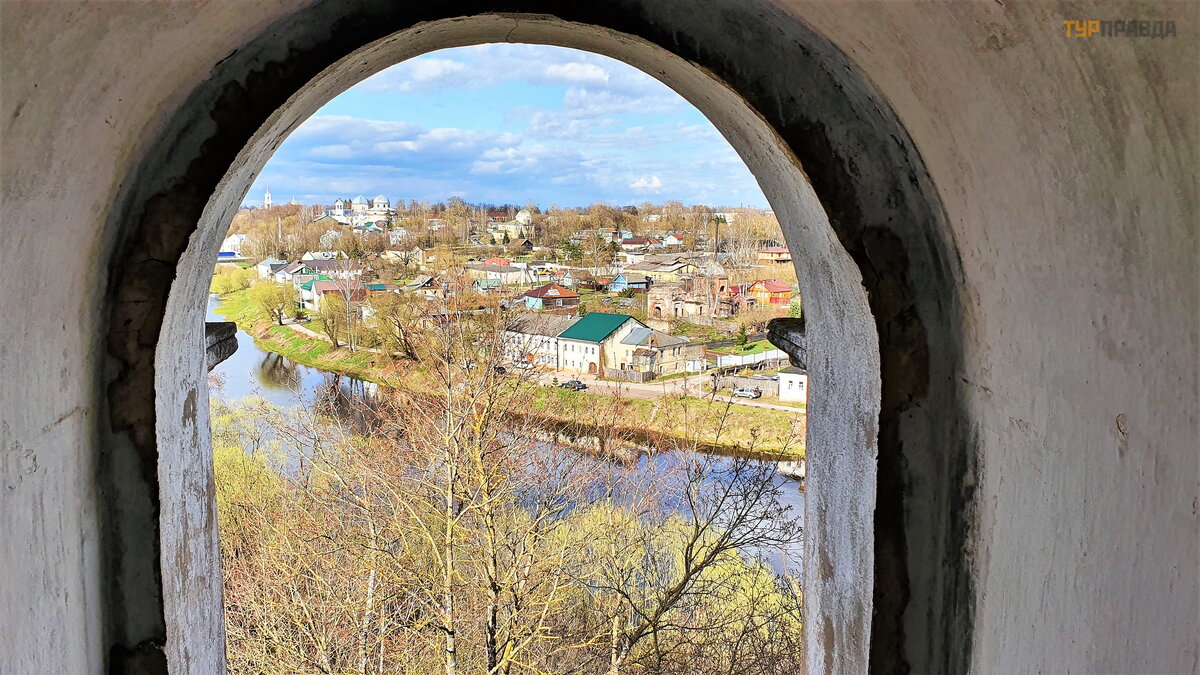
Виды не то, чтобы ВАУ, но весьма приятные.
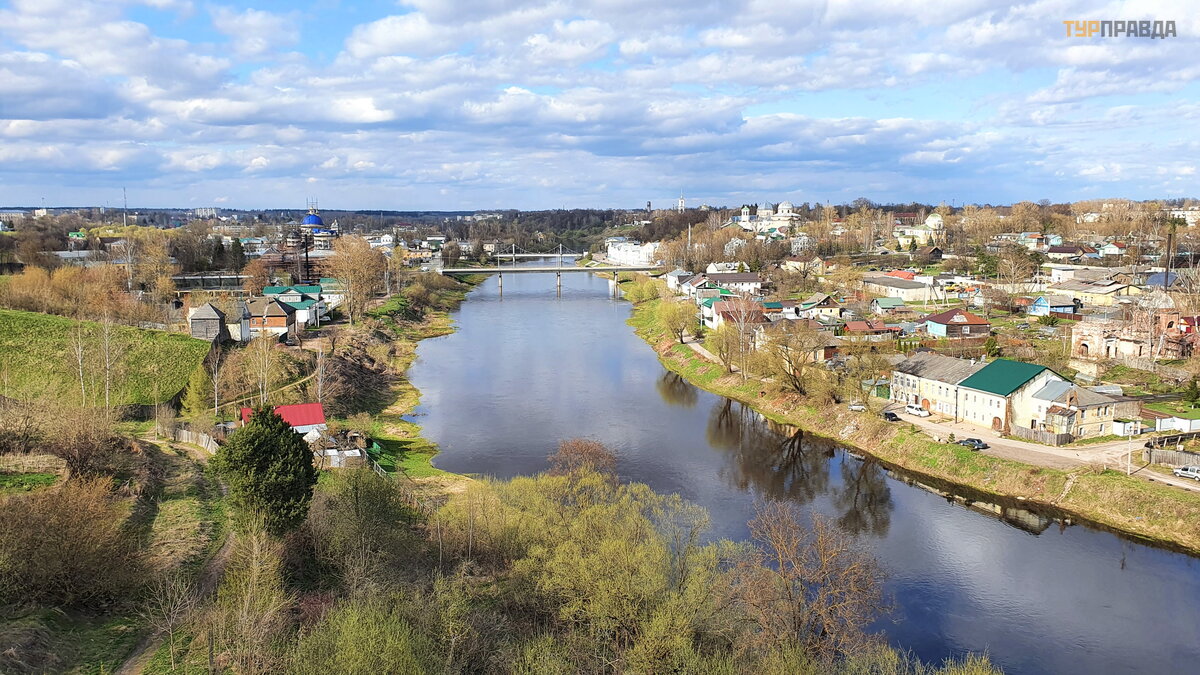
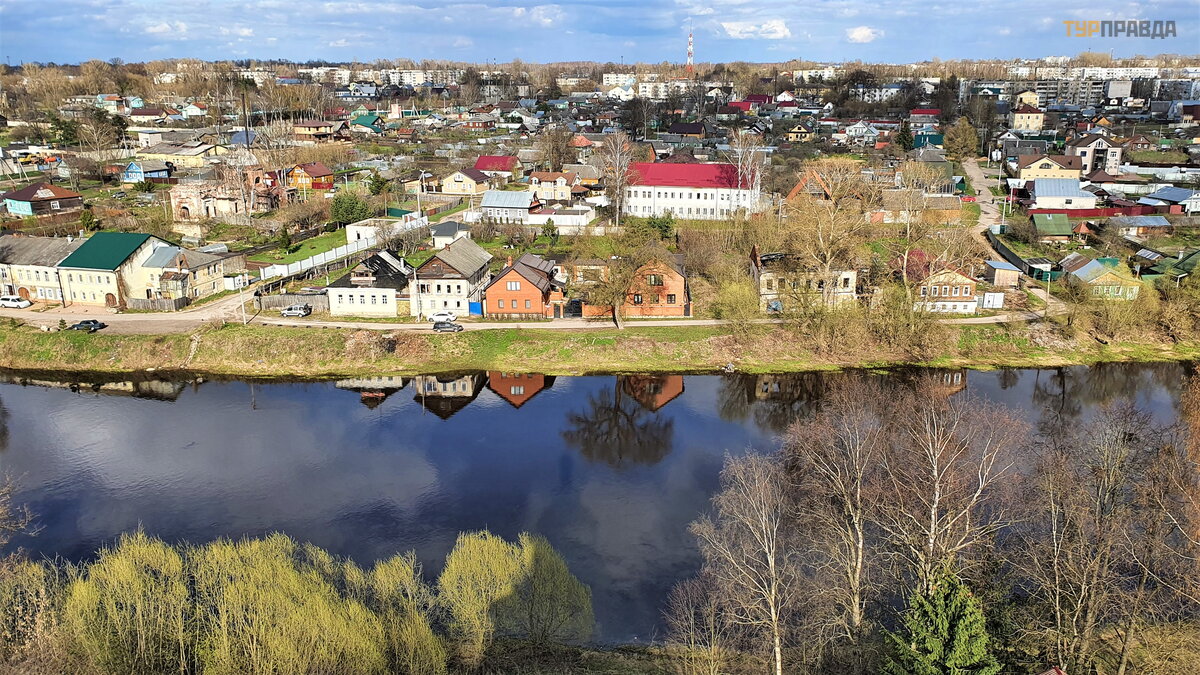
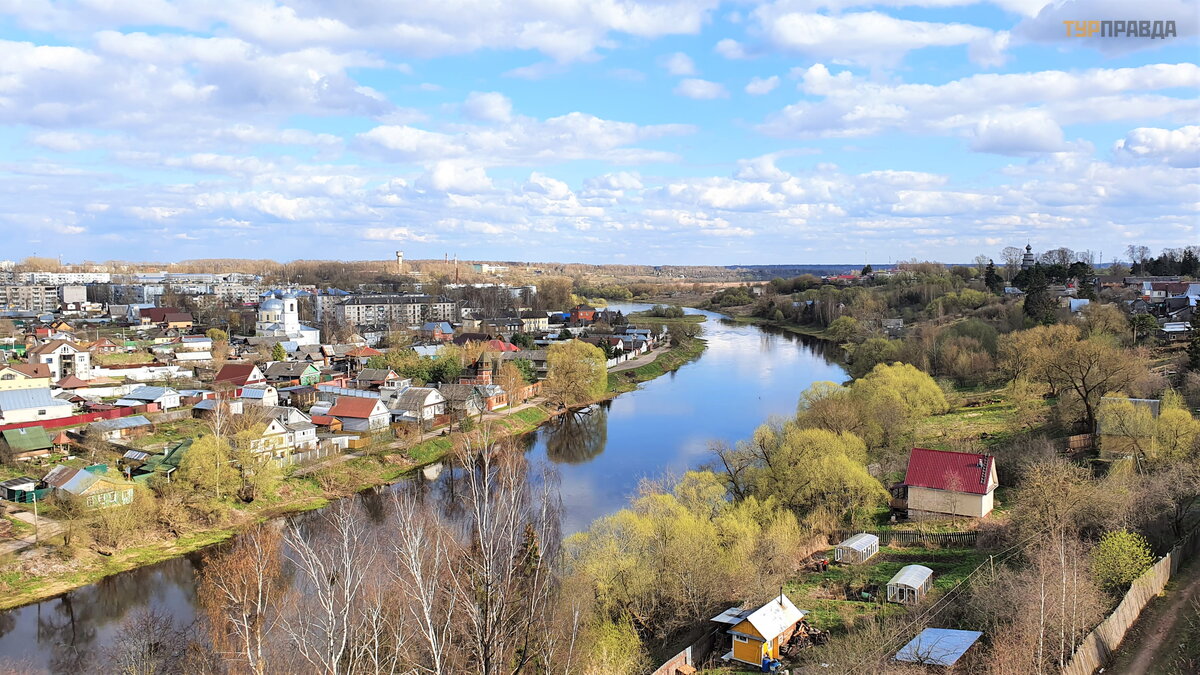
Ну, и чувство всеохвата и всеобзора всегда дополняет впечатления о посещенном месте.
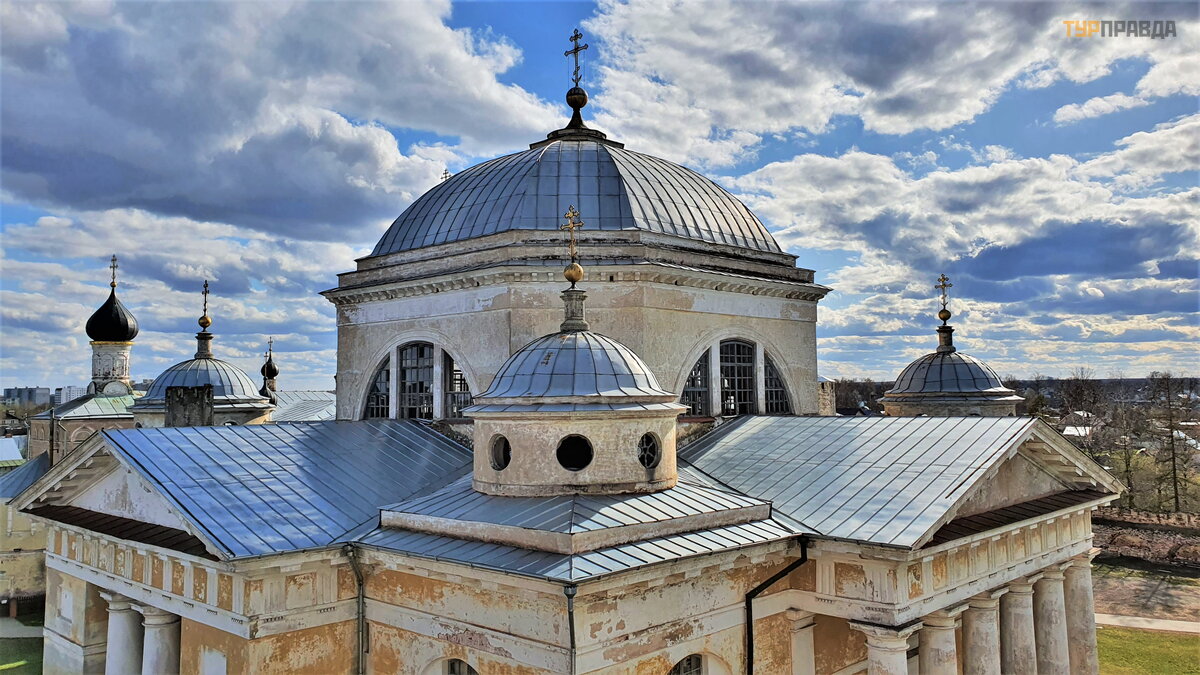
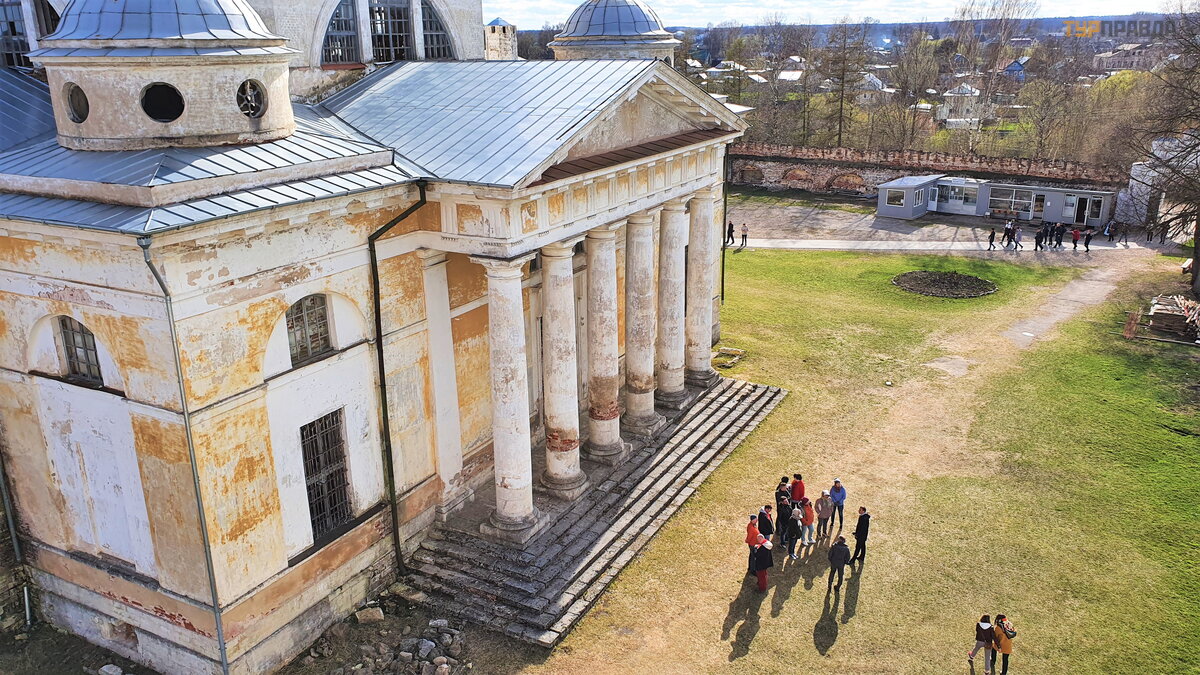
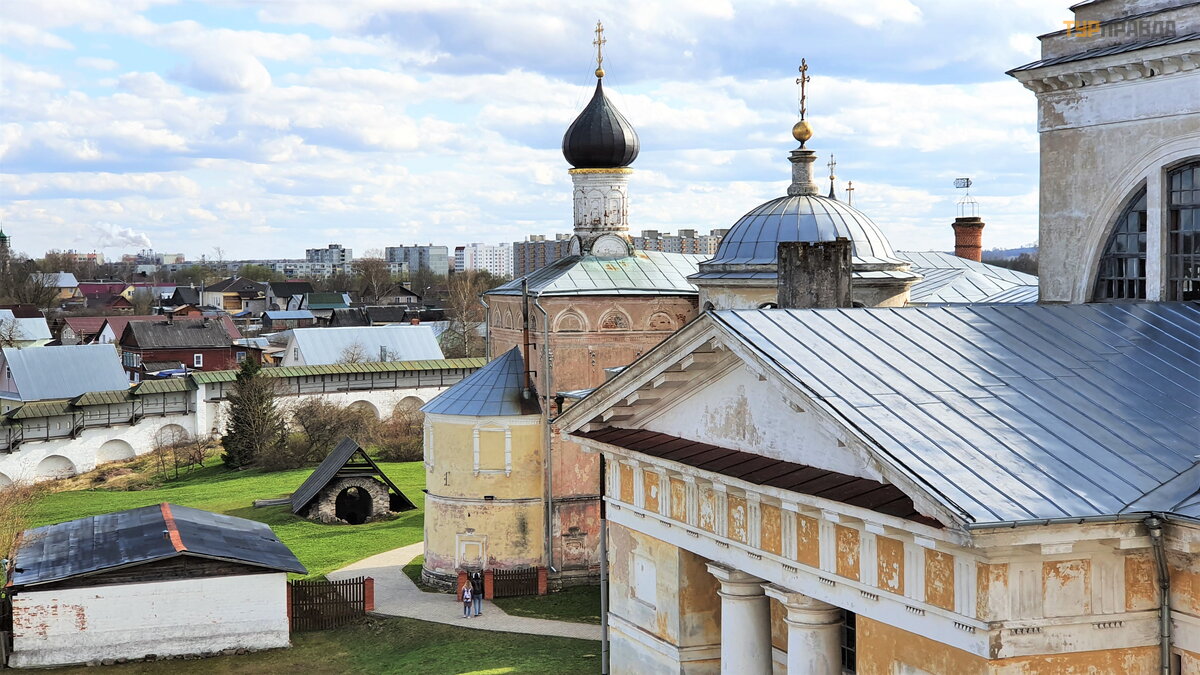
Кстати, про « римские масштабы» … Глядя на купол Борисоглебского собора охватили схожие чувства грандиозности, которые испытали в Пизе. Возможно, кто-то скажет, что преувеличение. Нет, не такие же, но близкие – это факт.
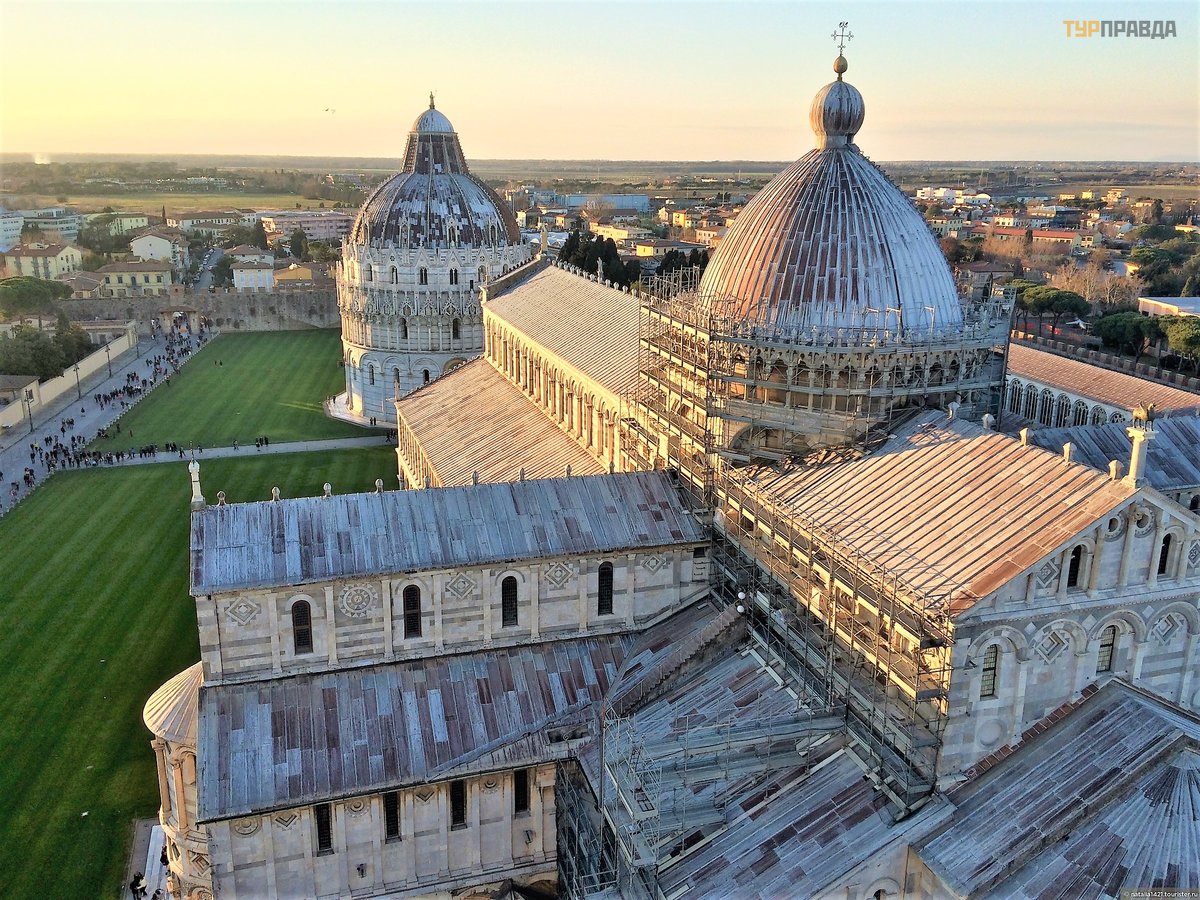 Вид на Кафедральный собор в Пизе с высоты Пизанской башни
Вид на Кафедральный собор в Пизе с высоты Пизанской башни
Когда-то эти виды свысока бывают началом знакомства, когда-то завершением осмотра, но всегда это одни из самых ярких эмоций.
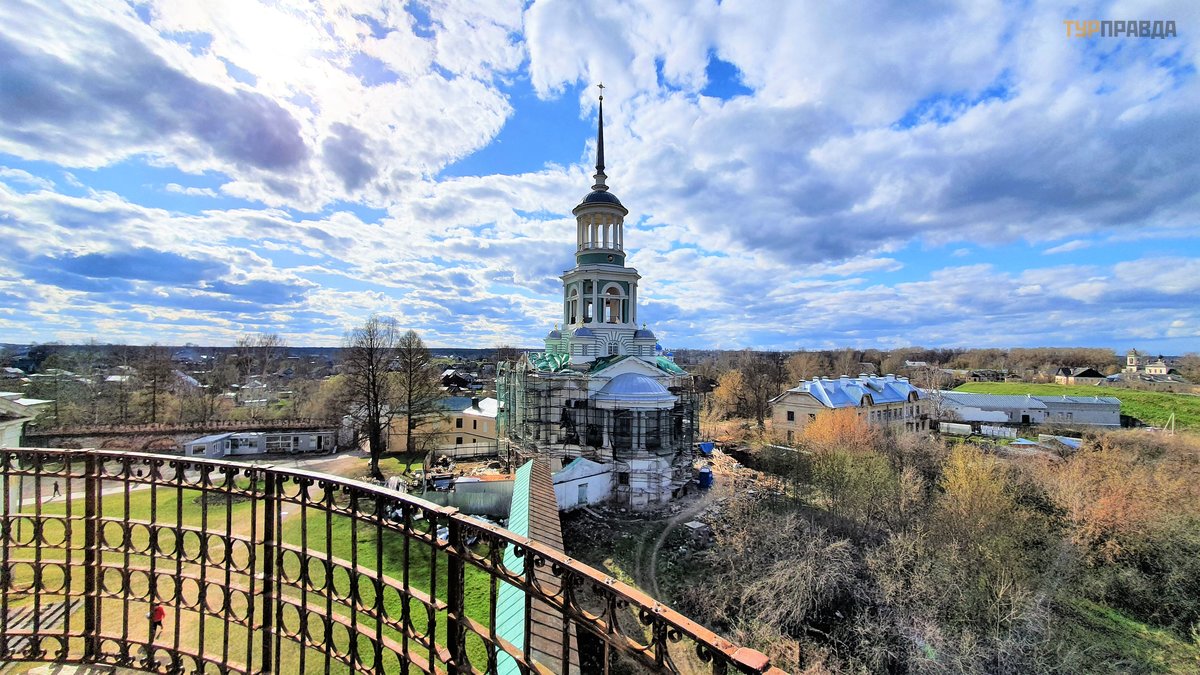 Святые врата с надвратной Спасской церковью и колокольней. До начала реставрации смотровая площадка была обустроена на колокольне
Святые врата с надвратной Спасской церковью и колокольней. До начала реставрации смотровая площадка была обустроена на колокольне
На соседнем холме от Борисоглебского монастыря красуется Благовещенская церковь.
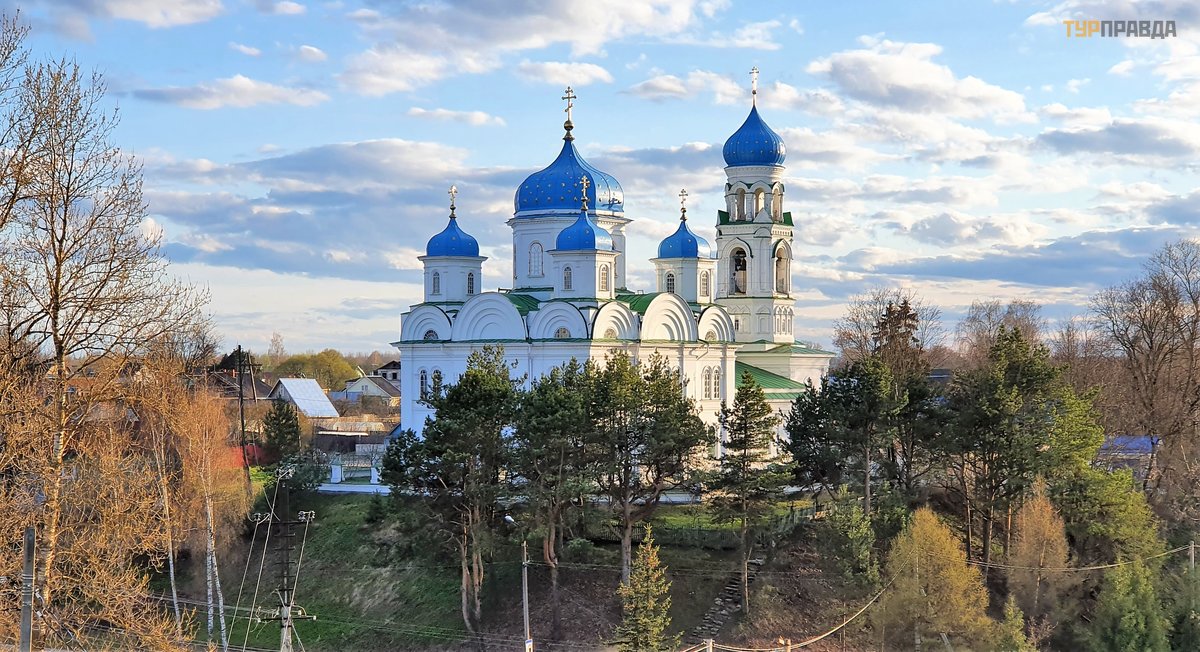 Вид с валов Новоторжского кремля
Вид с валов Новоторжского кремля
О ней есть сведения еще с конца XVI – начала XVII веков. Она претерпела разорение литовцами, горела, перестраивалась… Современный вид – это постройка 1864 г. Церковь примечательна тем, что после закрытия в 30-х годах она открылась вновь в 1946-м. И вплоть до 1995 г. была единственным действующим храмом в городе.
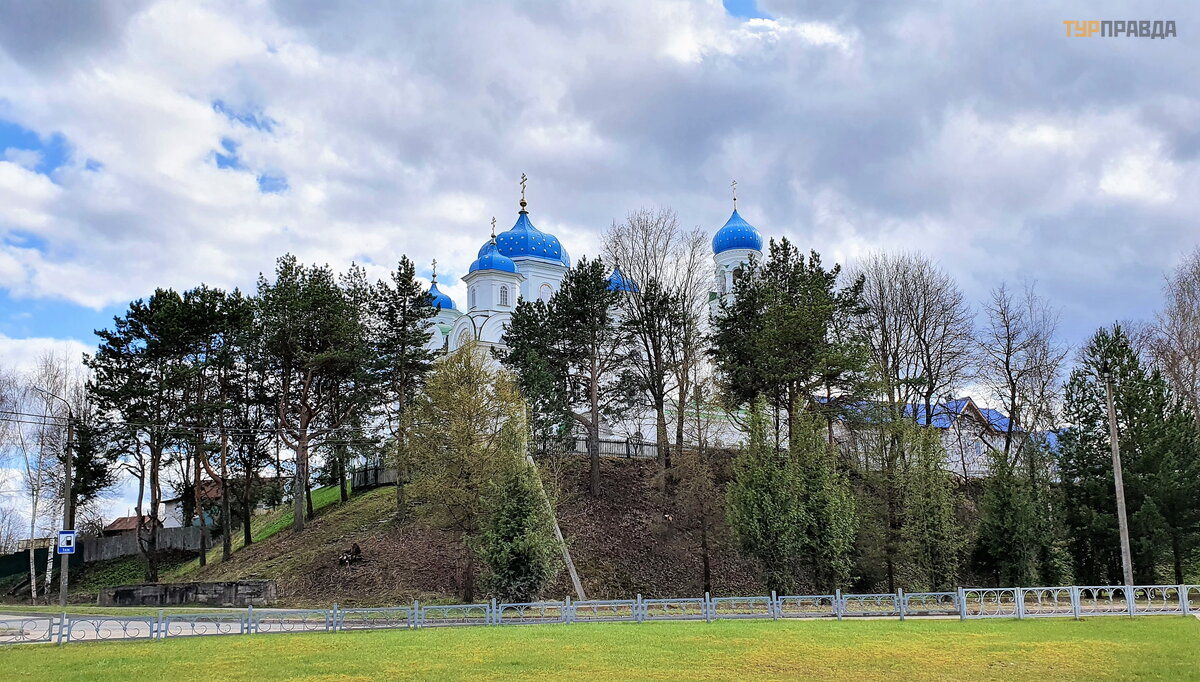
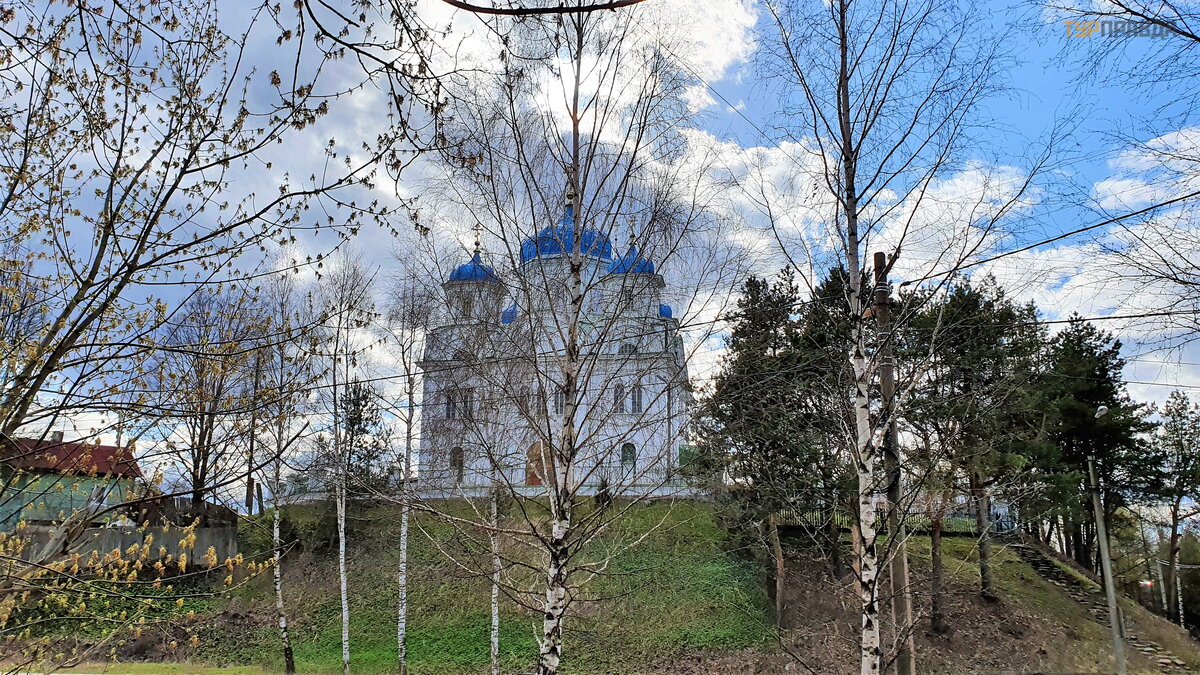
Георгиевская церковь. Как и большинство храмов, выстроена в камне в конце XVIII века на месте обветшавшей деревяной церкви.
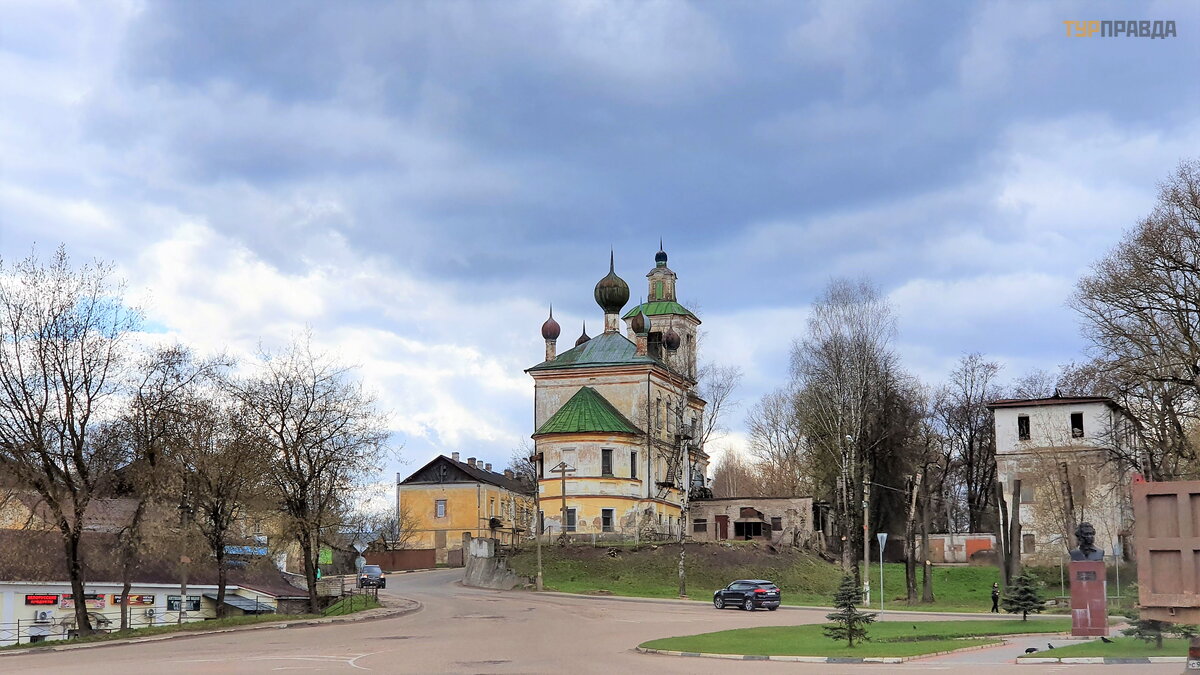
Современные очертания здание приняло в конце XIX века. С 30-х годов прошлого столетия и поныне строение используется для нужд сначала социалистического, а теперь и не пойми какого хозяйства. А в 1968 г. хуже того, ее чуть было не снесли для строительства новой дороги. Но силами активистов и краеведов удалось отстоять эту изящную красавицу.
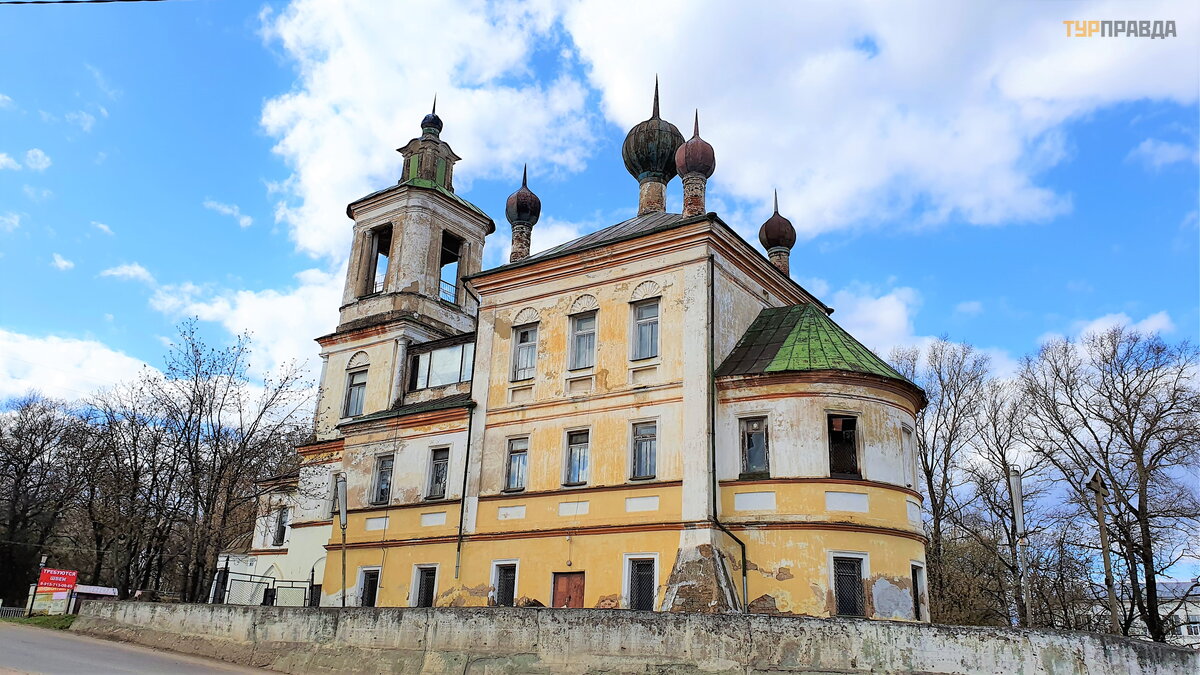
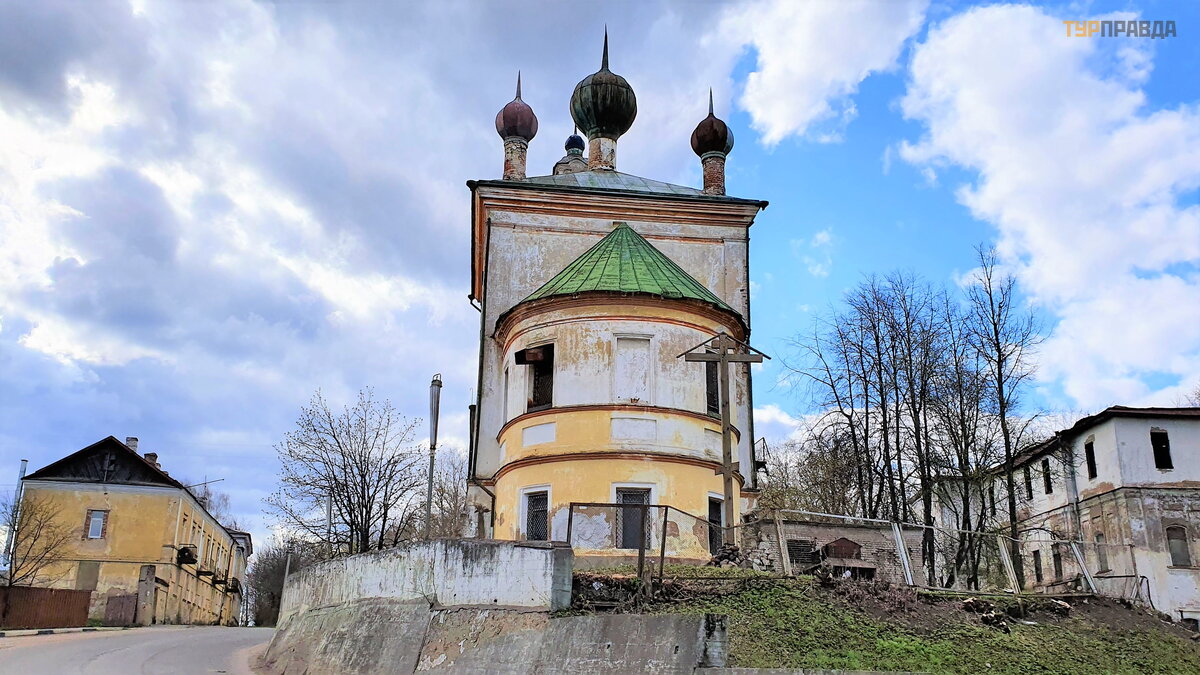
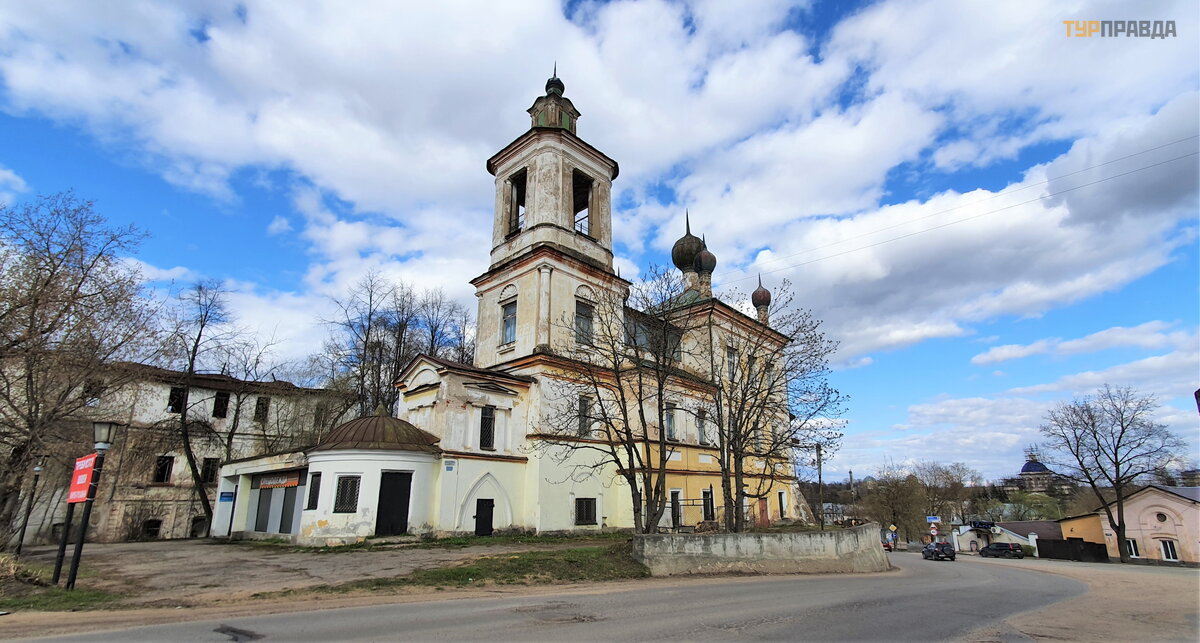
Спасо-Преображенский собор. История у него давняя.
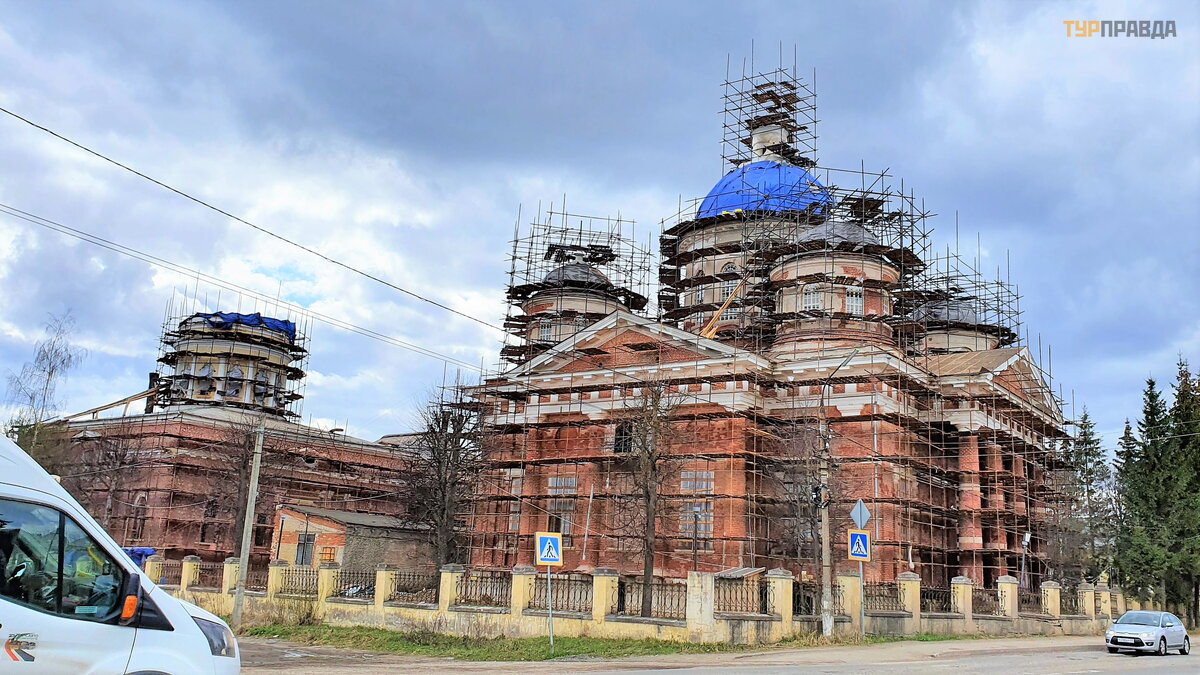
Первые упоминания относятся к 1163 г. Тогда, конечно, это была деревянная церковь, находящаяся на территории Новоторжского кремля. Храм несколько раз горел, разорялся, восстанавливался, перестраивался. Пришлось храму пережить страшную трагедию: в 1372 году, во время междоусобных войн, в соборе, только-только выстроенном в камне в 1364 г. , приняли мученическую смерть от огня и дыма горожане, укрывшиеся там от войска тверского князя Михаила Александровича, захватившего и разорившего город. Жестокие времена…
И еще одна печальная история сопровождает этот собор: « … В 1406 году здесь была погребена святая благоверная княгиня Иулиания, которая почитается как образец супружеского целомудрия. Иулиания была женой вяземского князя Симеона Мстиславовича. После завоевания Смоленска Литвой, они разделяли изгнание с родной земли вместе со смоленским князем Юрием Святославичем. Великий князь Василий Московский дал им в удел город Торжок. И всё бы ничего, но здесь князь Юрий начал приставать к Иулиании и получил достойный отпор. Тогда во время пира Юрий убил мужа Иулиании, а ей самой отрубил руки и ноги. Больной крестьянин увидел, что по реке Тверце плывёт против течения тело убиенной княгини, и услышал голос, повелевший собрать духовенство и совершить погребение тела у южных дверей Спасо-Преображенского собора. С тех пор ко гробу княгини постоянно приходили люди с верой в благодатную помощь святой. Мощи, кстати, в 1930 году были вскрыты и утеряны» (Взято отсюда)
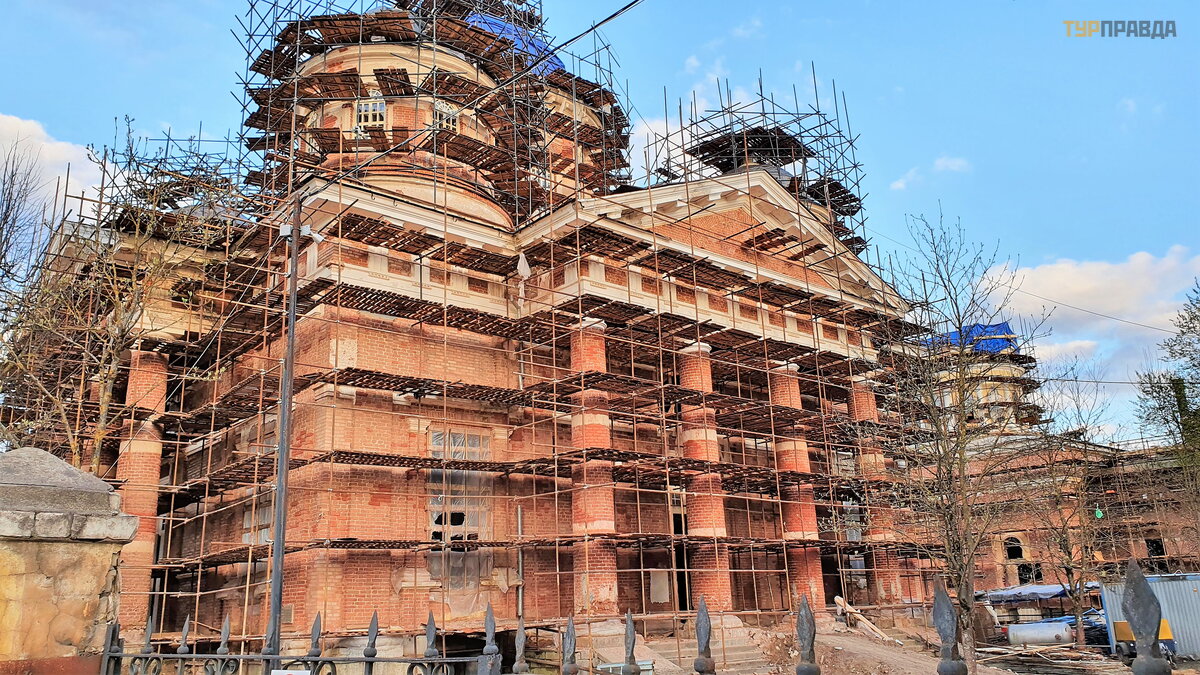
Это величественное здание построено уже в 1812-22 гг. по проекту известного зодчего того времени Карла Росси. В данный момент идет очередная масштабная реставрация, в 70-х годах прошлого века таковая уже проводилась.
 Вид с валов Новоторжского кремля
Вид с валов Новоторжского кремля
Храм получился настолько большим, что отапливать его было очень дорого. В результате через 20 лет в 1842 г. рядом появилась зимняя Входиерусалимская церковь, построенная по проекту губернского архитектора Ивана Федоровича Львова.
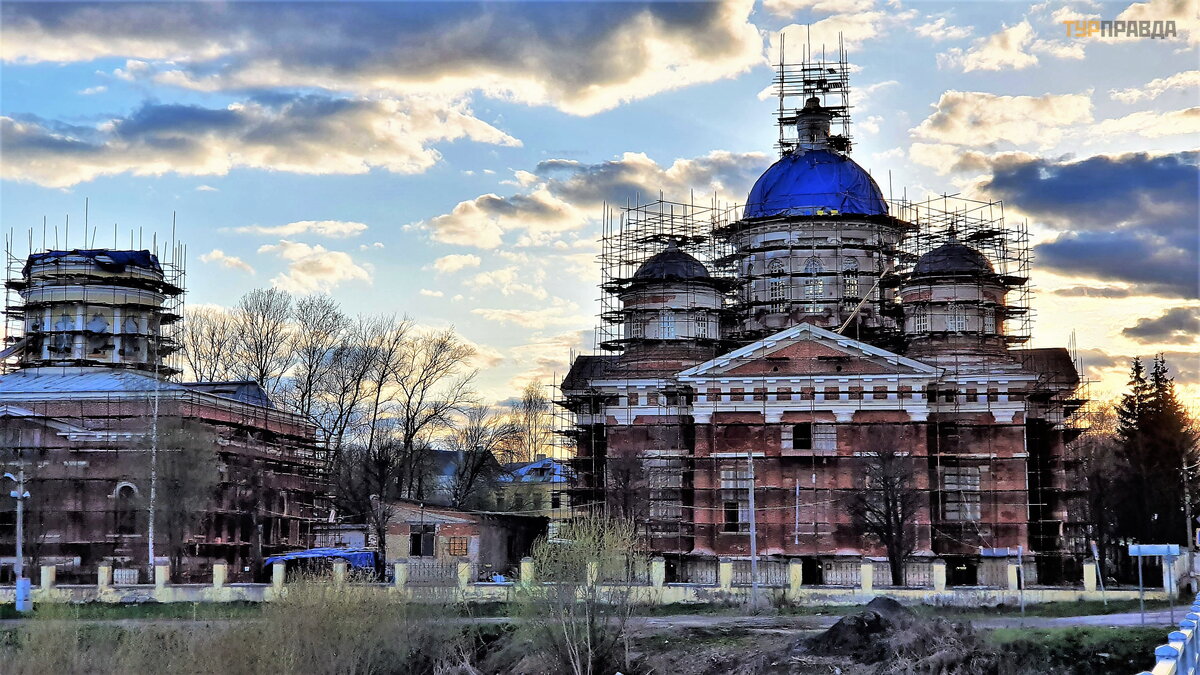
Для общего представления, как это выглядело, стащила фото из интернета:
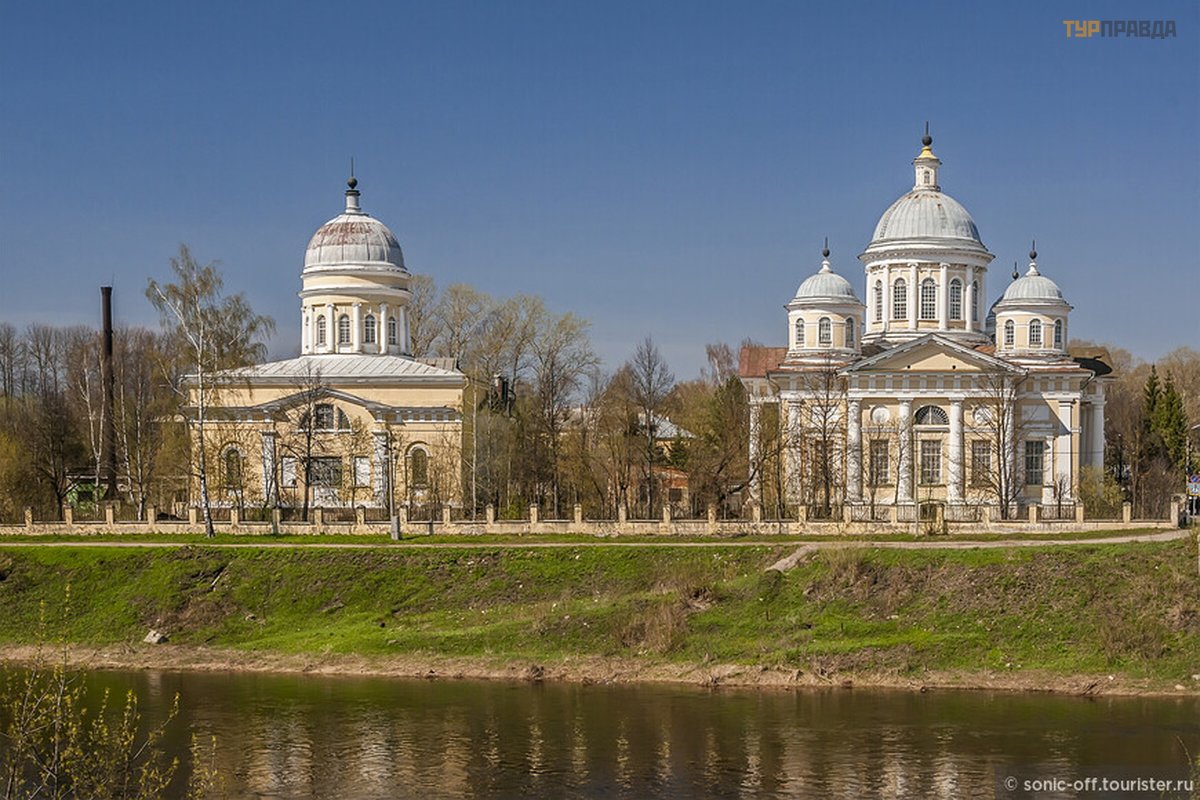 Автор Евгений (https://sonic-off. tourister. ru/)
Автор Евгений (https://sonic-off. tourister. ru/)
По пути к моей заветной цели – комплексу бывшего Вознесенского монастыря, купола которого видны отовсюду, неожиданно повстречалащь еще одна любопытная церковь из « бывших» прямо на пересечении дорог – Крестовоздвиженская церковь.
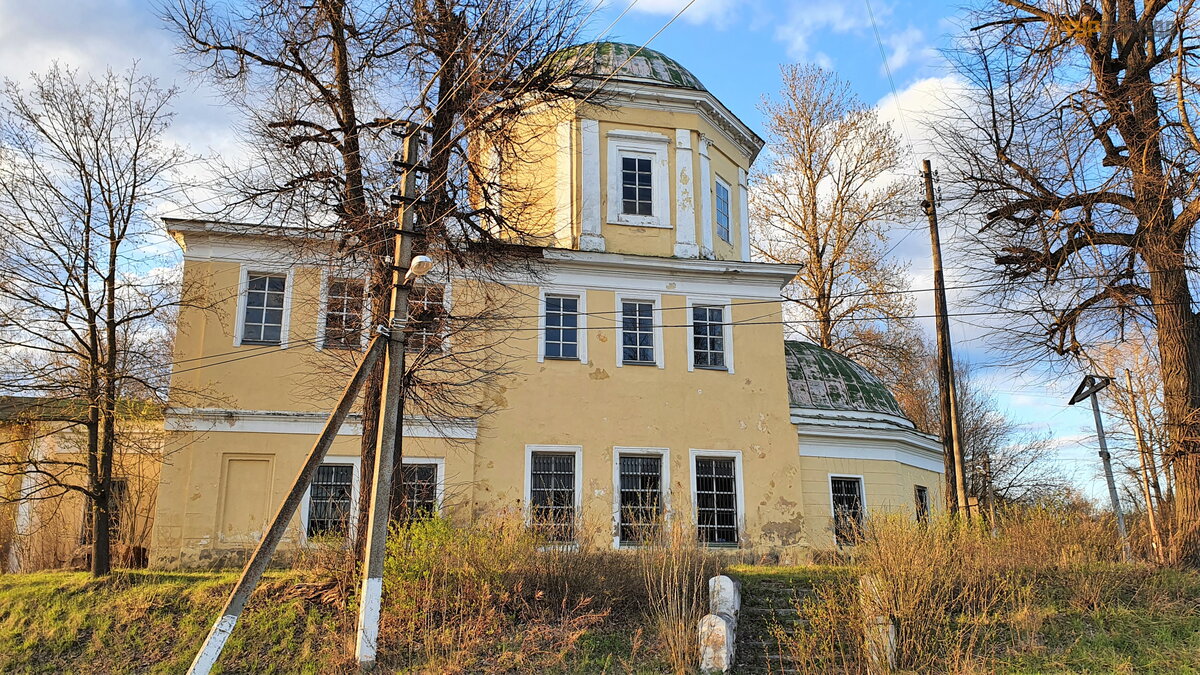
Данное строение сооружено в 1842 г. , как водится, на месте старой обветшавшей церкви. А еще раньше была деревянной. Не нашла информации, что было в здании после закрытия в 1929 г. В последние годы вроде как ателье.
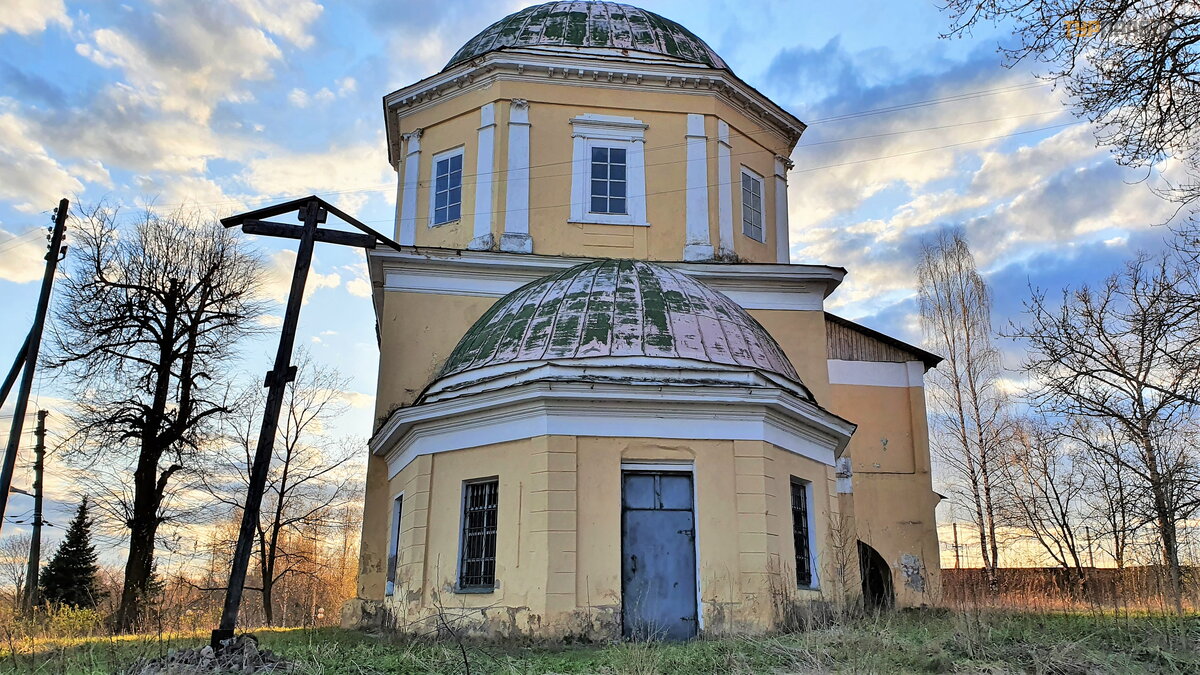
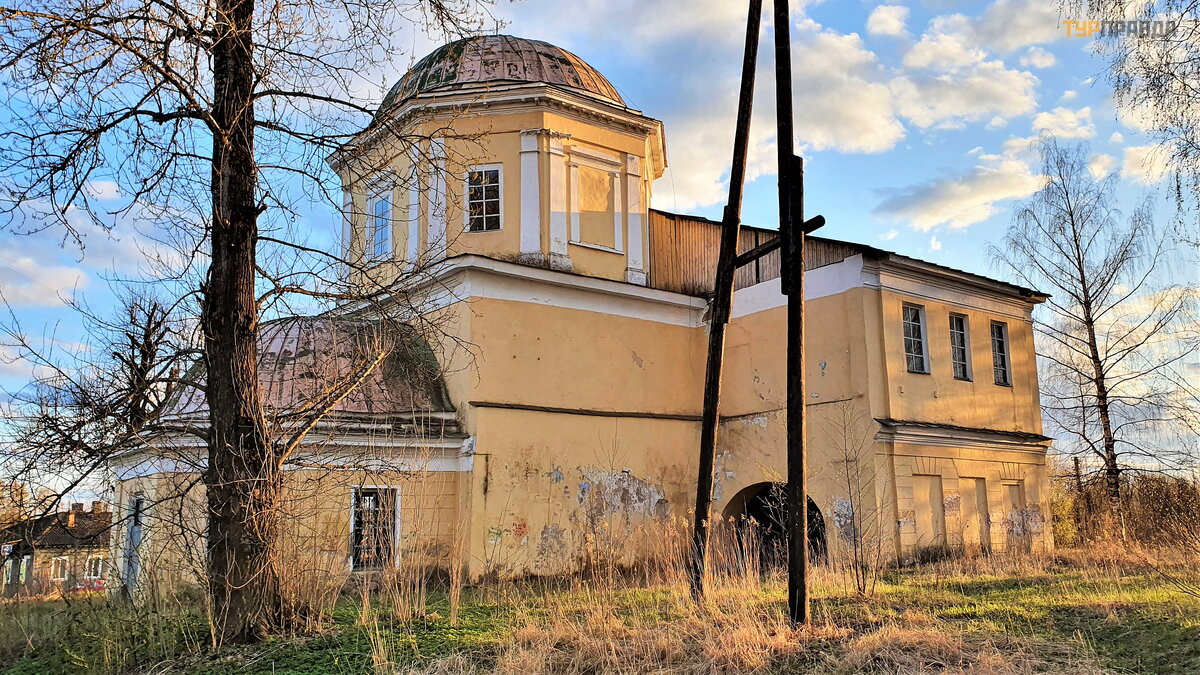
В настоящий момент передано Борисоглебскому монастырю, но пока, как говорится, руки не дошли.
Воскресенский женский монастырь:
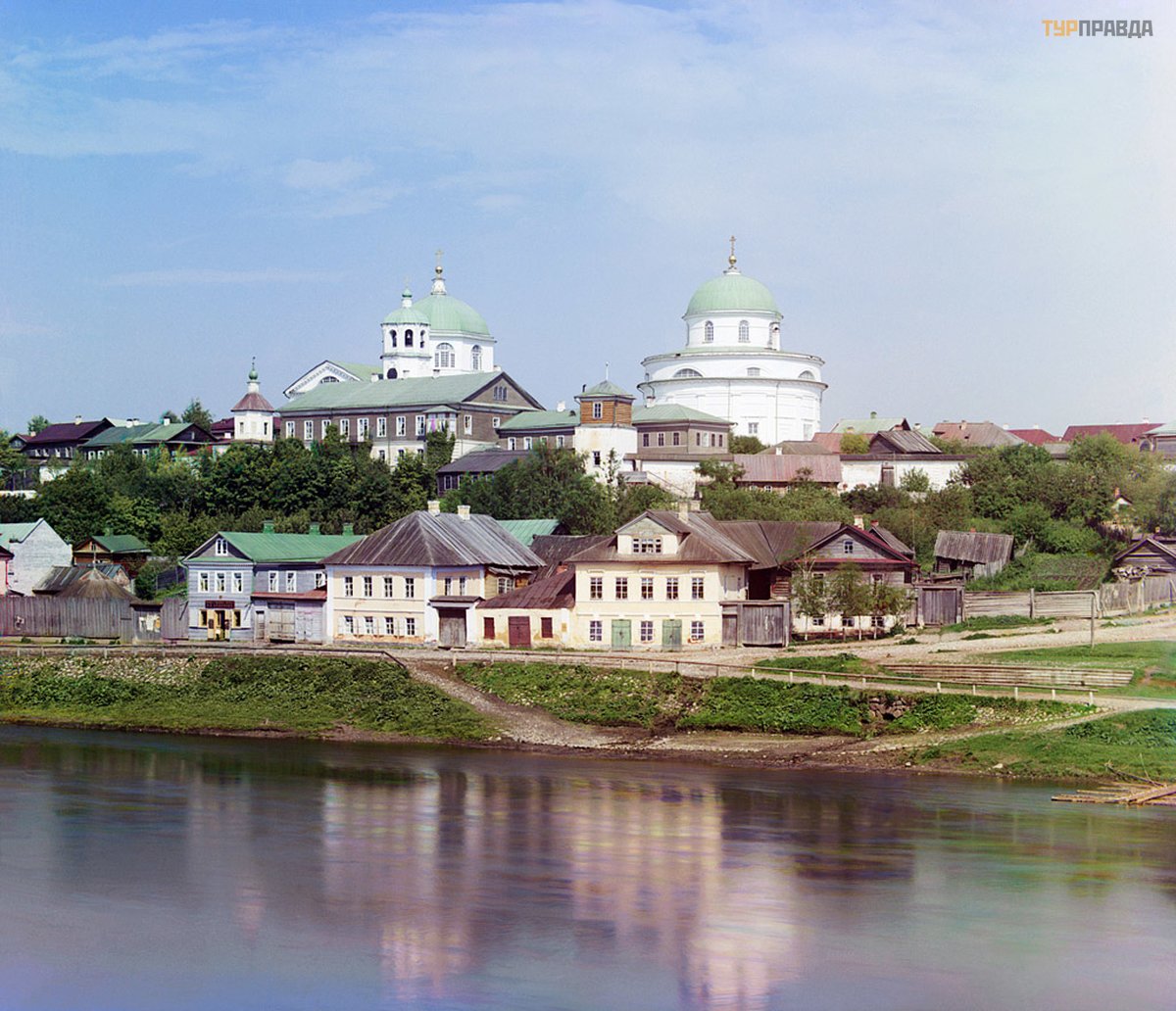 Фото С. М. Прокудина-Горского, 1910 г. Сравните со вторым фото по тексту
Фото С. М. Прокудина-Горского, 1910 г. Сравните со вторым фото по тексту
Первые упоминания о нем относятся к 1584 г. Но на самом деле монастырь возник задолго до этой даты. Существует легенда, что между Воскресенским женским монастырем и Борисоглебским мужским, находящимся на противоположном берегу Тверцы, был подземный ход. Но это, конечно, лишь пустая болтовня, порожденная, возможно, когда-то чьей-то шуткой. Во всяком случае, историки и археологи сей факт опровергают.
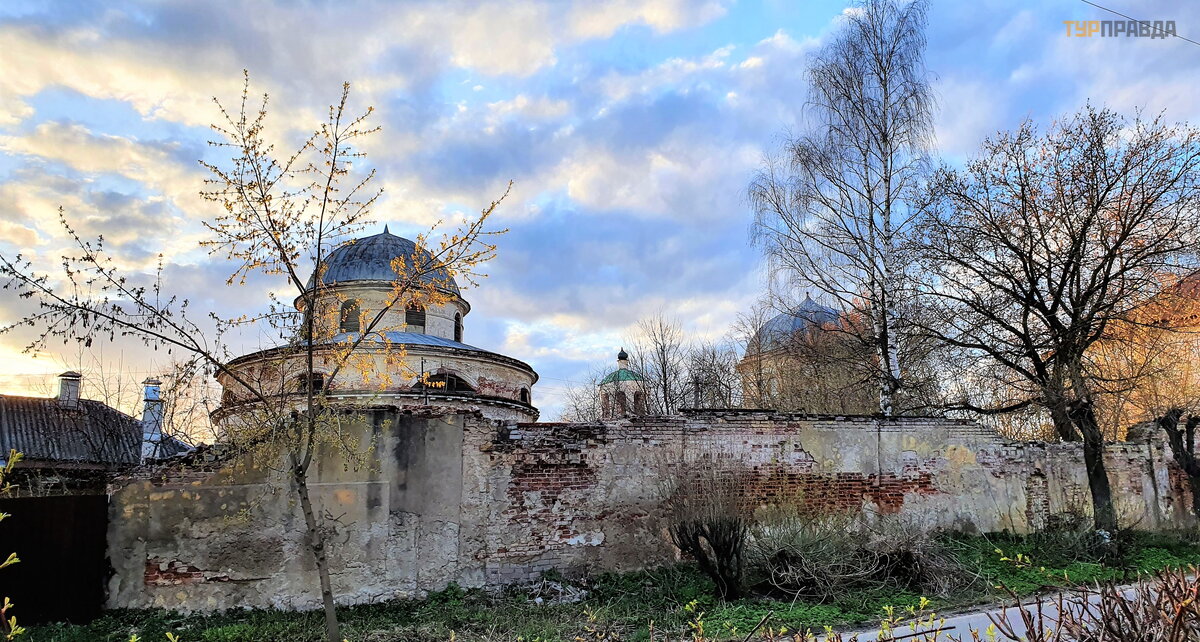
К XIX веку монастырь стал богатой и влиятельной обителью. При нем существовал приют для девочек-сирот, а позже было открыто и училище для бедных девиц духовного звания. Многие выпускницы стали сельскими учителями. В монастыре действовали мастерские по золотному шитью, в которых создавались наряды и для царских особ. Во многом благодаря монастырю этот древний промысел дошел до наших дней.
С приходом советской власти монастырь был закрыт. Некоторые здания сейчас используются швейной фабрикой. А используются ли?
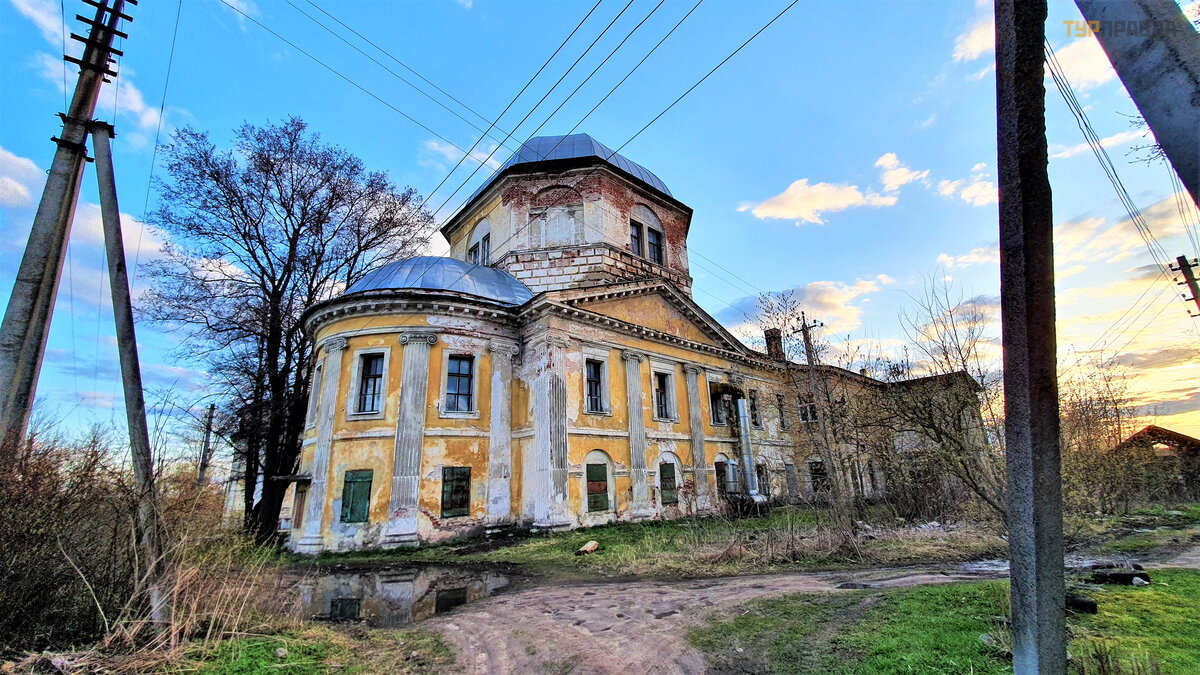
До наших дней сохранился Воскресенский собор 1796 года постройки, колокольня, необычная Предтеченская церковь, построенная в 1840 г. по проекту И. Ф. Львова.
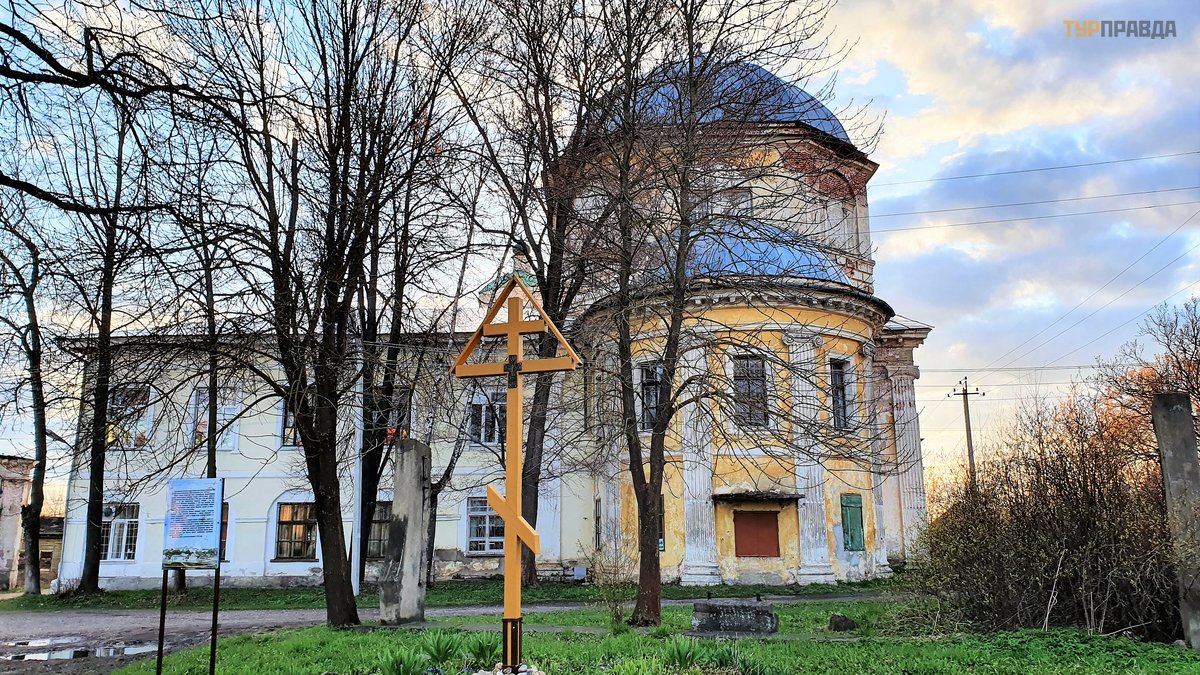 Воскресенский собор
Воскресенский собор
 Колокольня Воскресенского собора
Колокольня Воскресенского собора
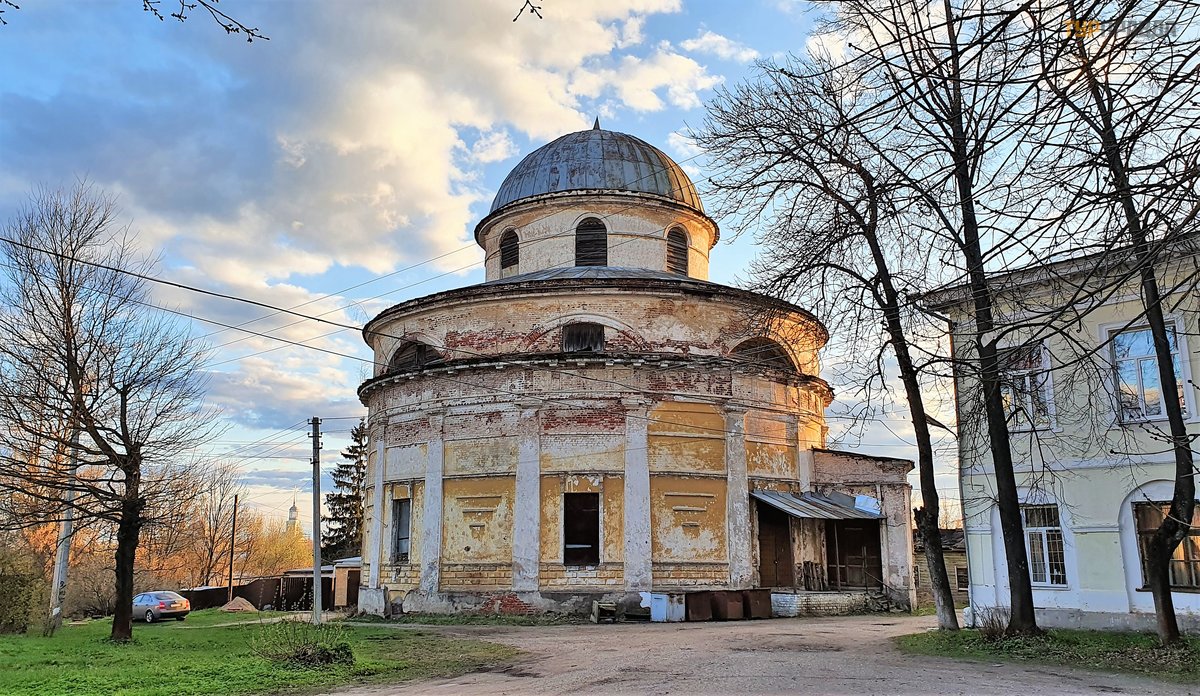 Предтеченская церковь
Предтеченская церковь
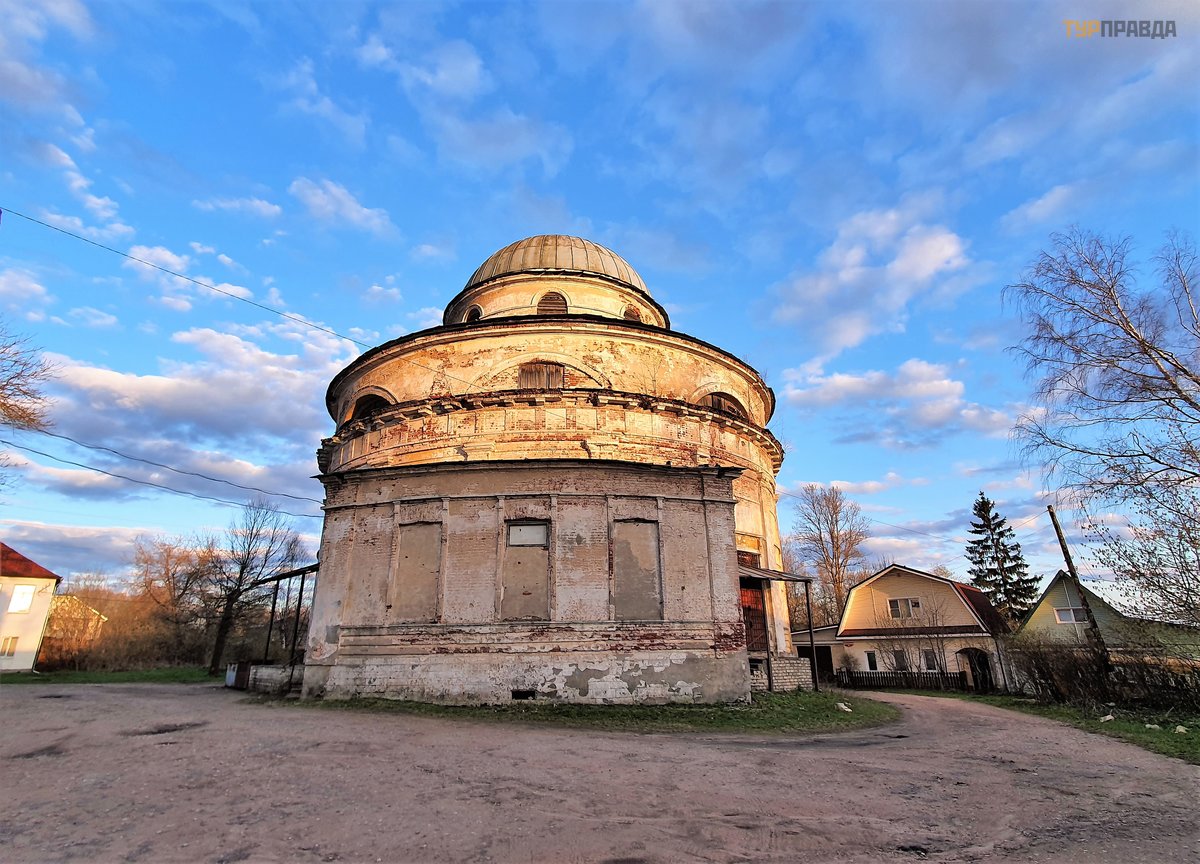 Предтеченская церковь
Предтеченская церковь
Будучи в Торжке, мы разместились в отеле « Торжок» 3*. Гостиница очень такая симпатичная, честно, даже приятно удивила. Она не так, чтобы в самом центральном центре, но беря в расчет игрушечные размеры городка (ну, то что интересно разгуливающему туристу), то данный факт не имеет никакого значения : )). Впрочем, подробнее о ней в отдельном отзыве.
Так вот, так получилось, что первой достопримечательностью, с которой мы познакомились в городе, а потом и вечером закончили свой маршрут, стала Ильинская церковь, находящаяся неподалеку от места ночлега.
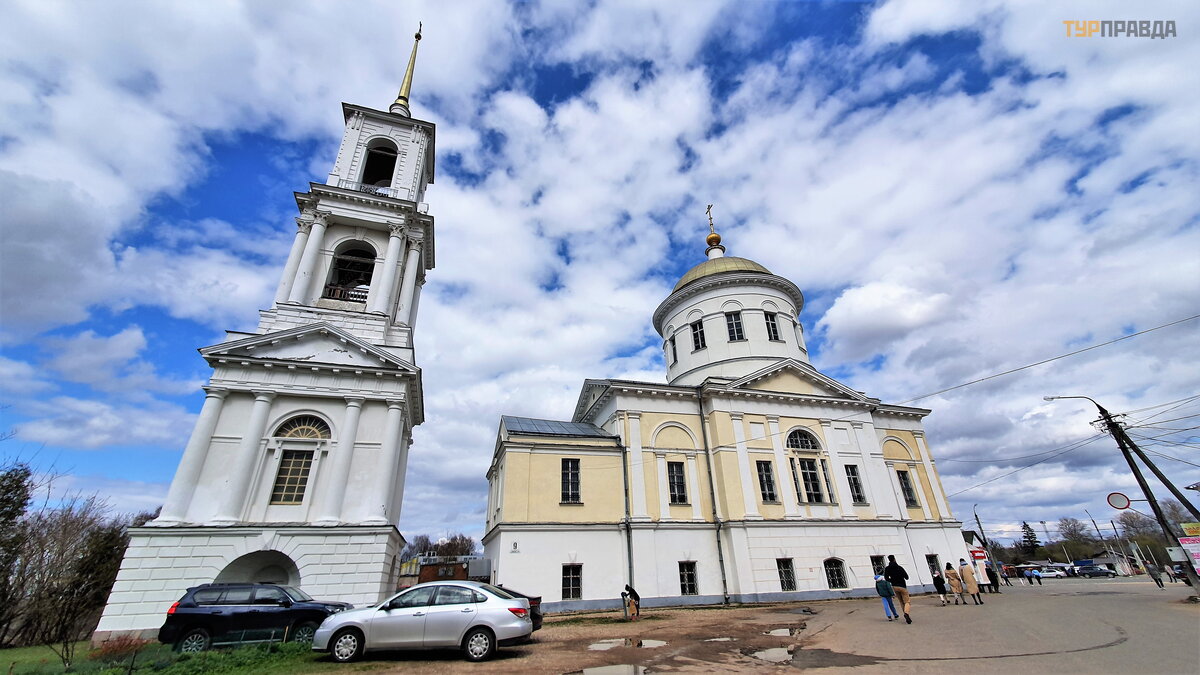
Построена в 1822 г. на месте церкви, ставшей маленькой для большого количества прихожан. Как и многие культовые сооружения, была закрыта в 1929 г. , после чего здание использовалось под общежитие. В 70-х годах была отреставрирована, но в лоно Церкви ее вернули только в 2005 г. , а до этого там находилась школа бокса. В общем-то ничего особенного, обычная судьба церквей, но… Есть один любопытный факт, к сожалению, печальный. Именно в этом храме 13 февраля 1826 г. в его нижней « зимней» части было поставлено на ночь тело императора Александра I, перевозимое из Таганрога, где тот скончался от горячки. И уже 31 мая того же года там было поставлено и тело супруги императора – Елизаветы Алексеевны, скончавшейся в Белёве Тульской губернии и перевозимой в Петербург через Торжок. Такая вот история.
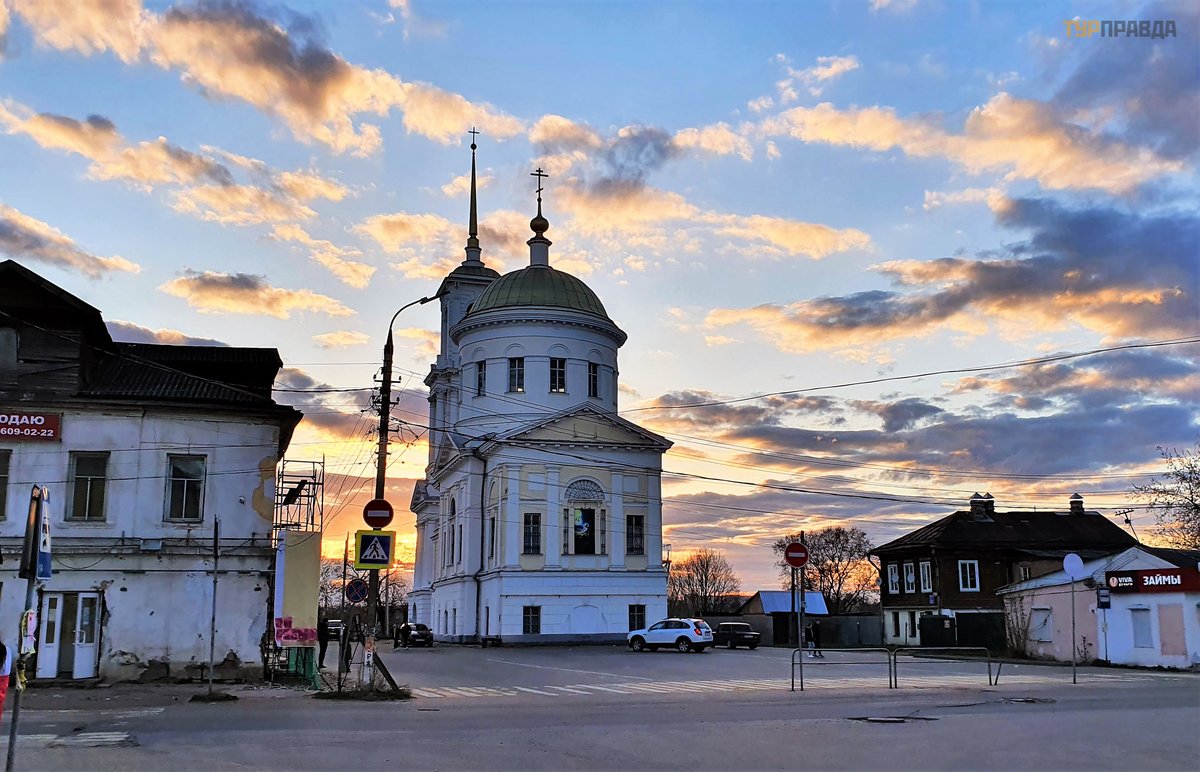 Ильинская церковь. Вечерний взгляд
Ильинская церковь. Вечерний взгляд
Это лишь то немногое, что мы смогли « зацепить» по маршруту пешего следования.
Много разных городов и городков повидали. Но, пожалуй, Торжок – один из самых « богатых» на церкви и храмы на единицу площади, так сказать. И таких величественных для малого городка. Очень грустно, конечно, видеть разруху и запустение. Но все эти храмы, как стойкие богатыри, держатся. Ждут…
P. S. Из той же серии:
О прогулке по улочкам города " Торжок. Нет некрасивых городов" .

When you go out on the banks of the Tvertsa River in Torzhok, the first thing that catches your eye is a large number of churches. Wherever you look - everywhere domes and cupolas. Somewhere small and slender. . .
 Makovki St. George's Church. View from the ramparts of the Novotorzhsky Kremlin
Makovki St. George's Church. View from the ramparts of the Novotorzhsky Kremlin
. . . somewhere huge and majestic.
 Domes of the former Ascension Monastery
Domes of the former Ascension Monastery
But, unfortunately, many without crosses. This is already a legacy of the Soviet era. Solid stone buildings of churches were used for the needs of the national economy. By the end of the 20th century, this economy was gone, many buildings fell into disrepair. Something managed to return the ROC. But often this returned turned out to be not very necessary. Let's hope this is temporary. Well, a lot of things still stand in desolation, often in ruins.
 Vlasievskaya Church. It seems like restoration even began
Vlasievskaya Church. It seems like restoration even began
 Resurrection Church
Resurrection Church
But my message is not to criticize local authorities and business entities. This has already been said and discussed, written and rewritten. I'm talking about something else.
I think that many, in fact, like me, when visiting the provincial Torzhok, the question arose: where did such huge temples come from in this tiny town? Definitely Roman scale. Well, yes, great in small. . .

The fact is that Torzhok has not always been a simple provincial town. And now, what is there, well, quite a village (no offense), but very charming.
 st. Krasnaya Gorka
st. Krasnaya Gorka
No one knows the exact date of the founding of the city, presumably the turn of the X-XI centuries. It was originally created as a place of bargaining by Novgorod merchants - Novy Torg. So it was known for many centuries as a rich trading city. Although it was repeatedly ruined by both Batu and the Poles, it was revived again and again, as it was conveniently located on trade routes. By the 19th century, 70% of the population were merchants. Rich people tried in every possible way to perpetuate their names. The most fashionable, let's say, in those days was to donate funds to a charitable cause - the construction of a temple, for example, you see, maybe it will be counted in the next world. In addition, they built their own churches, and the more, the cooler, to put it in a modern way. Yes, and not very rich townspeople built temples in settlements and settlements, and they were also not averse to competing with each other with the richness of the forms and decoration of their churches. This was, is, and will be. Only each time has its own objects of competition.
If you're interested, let's take a closer look at some of the temple objects of Torzhok. They beckon with their shapes and silhouettes. I used to take my family around the city by hook or by crook, just to look at the tuuu hulk or woo that...

The family, consisting of a father and two offspring 10 and 9 years old, made attempts to resist. Not without difficulties, as they say : ). And this fact really annoys me on family trips. And what to do, there is nowhere to put the cubs, they also need to be enlightened. But we learned to find compromises, so something worked out.
The main point of attraction for Torzhok is Borisoglebsky Monastery.

Novotorzhsky Borisoglebsky Monastery is one of the oldest Orthodox monasteries on Russian soil. It was founded in 1038 by St. Ephraim. Ephraim served as a groom for the brothers of the princes Boris and Gleb, the younger sons of Vladimir Svyatoslavich, who, due to fears of losing the throne, were killed by their elder brother, Prince Svyatopolk of Kyiv. After the death of his brothers, the faithful servant left the worldly life and went to the Novgorod lands in search of peace and quiet. After long wanderings and wanderings on a high hill on the banks of the Tvertsa River, he remained to pray for the repose of Boris and Gleb.
 Monument to St. Ephraim of Novotorzhsky. Installed in 2015
Monument to St. Ephraim of Novotorzhsky. Installed in 2015
Gradually, the monastery grew. And after some time, Novgorod merchants settled nearby, so the city of Novy Torg was born, which we now call Torzhok. According to another version, Ephraim settled on a nearby hill near the city that already existed at that time.

Since those ancient times, of course, nothing has been preserved.
 Entrance Church of Jerusalem (1717), rectory building (1717)
Entrance Church of Jerusalem (1717), rectory building (1717)
 The monastery wall (late 18th century)
The monastery wall (late 18th century)
 Vvedenskaya Church (1620) - most old preserved monastery building
Vvedenskaya Church (1620) - most old preserved monastery building

This was facilitated by numerous ruins, and, conversely, wealth and power. Yes, it happens. In the XVIII-XIX centuries, the monastery flourished, and he could afford to rebuild. As a result, new buildings were erected to replace the old and dilapidated ones. The architectural image of the monastery was formed by the beginning of the 19th century.

After closing in 1925, the monastery became a high-security prison for many years, then alcoholics were treated there. At the end of the 80s. of the last century, the complex was transferred to the jurisdiction of the historical and ethnographic museum. And since that time, little by little, the revival of the monastery begins. But everything is kind of slow. I saw photos of past years, Borisoglebsky Cathedral was in the woods. The scaffolding was removed, the cathedral apparently remained in its original state.
 Borisoglebsky Cathedral (1796)
Borisoglebsky Cathedral (1796)
 Borisoglebsky Cathedral (1796)
Borisoglebsky Cathedral (1796)
At the moment, Borisoglebsky Monastery is the brightest sight of the city of Torzhok. For ubiquitous and all-climbing tourists, an observation deck is organized in the Candle Tower.
 The Candle Tower (1809)
The Candle Tower (1809)


Having learned about this event, I really urged my companions, I was afraid that I would be late, as I did not have an exact work schedule. I really love all these "viewing" cases. And I recommend it to you too.

The views are not that WOW, but very pleasant.



Well, the feeling of all-encompassing and all-encompassing always complements the impressions of the visited place.



By the way, about the "Roman scales". . . Looking at the dome of St. Boris and Gleb Cathedral, we were seized by similar feelings of grandiosity that we experienced in Pisa. Some might say it's an exaggeration. No, not the same, but close - that's a fact.
 View of Pisa Cathedral from the height of the Leaning Tower of Pisa
View of Pisa Cathedral from the height of the Leaning Tower of Pisa
Sometimes, these views from above are the beginning of an acquaintance, once the end of an inspection, but they are always one of the most vivid emotions.
 The Holy Gates with the Gateway Church of the Savior and the bell tower. Prior to the restoration, the observation deck was built on the bell tower
The Holy Gates with the Gateway Church of the Savior and the bell tower. Prior to the restoration, the observation deck was built on the bell tower
The Annunciation Church flaunts on the neighboring hill from the Borisoglebsky Monastery.
 View from the ramparts of the Novotorzhsky Kremlin
View from the ramparts of the Novotorzhsky Kremlin
There is information about it from the end of the 16th - beginning of the 17th centuries. It was devastated by the Lithuanians, burned, rebuilt... The current look is the construction of 1864. The church is notable for the fact that after closing in the 30s, it was reopened in 1946. And until 1995 it was the only functioning church in the city.


St. George's Church. Like most churches, it was built in stone at the end of the 18th century on the site of a dilapidated wooden church.

The building took its modern shape at the end of the 19th century. From the 30s of the last century to this day, the building has been used for the needs of the first socialist, and now I don’t understand what kind of economy. And in 1968, worse than that, it was almost demolished to build a new road. But the activists and local historians managed to defend this graceful beauty.



Savior Transfiguration Cathedral. He has a long history.

The first mentions date back to 1163. Then, of course, it was a wooden church located on the territory of the Novotorzhsky Kremlin. The temple burned several times, was ruined, restored, rebuilt. The temple had to endure a terrible tragedy: in 1372, during the internecine wars, in the cathedral, just built in stone in 1364, the townspeople were martyred from fire and smoke, hiding there from the army of Prince Mikhail Alexandrovich of Tver, who captured and ruined city. Cruel times…
And one more sad story accompanies this cathedral: “. . . In 1406, the holy noble princess Juliana, who is revered as an example of marital chastity, was buried here. Juliania was the wife of the Vyazma prince Simeon Mstislavovich. After the conquest of Smolensk by Lithuania, they shared exile from their native land along with Prince Yuri Svyatoslavich of Smolensk. Grand Duke Vasily of Moscow gave them the city of Torzhok. And everything would be fine, but here Prince Yuri began to pester Juliana and received a worthy rebuff. Then, during the feast, Yuri killed Juliana's husband, and cut off her arms and legs herself. The sick peasant saw that the body of the murdered princess was floating against the current along the Tvertsa River, and heard a voice commanding to gather the clergy and bury the body at the southern doors of the Transfiguration Cathedral. Since then, people constantly came to the grave of the princess with faith in the grace-filled help of the saint. The relics, by the way, were opened and lost in 1930” (Taken here )

This majestic building was built already in 1812-22. designed by the famous architect of that time, Carl Rossi. At the moment, another large-scale restoration is underway; in the 70s of the last century, one was already carried out.
 View from the ramparts of the Novotorzhsky Kremlin
View from the ramparts of the Novotorzhsky Kremlin
The temple turned out to be so big that it was very expensive to heat it. As a result, 20 years later, in 1842, the winter Church of the Entrance of Jerusalem appeared nearby, built according to the project of the provincial architect Ivan Fedorovich Lvov.

For a general idea of how it looked, I stole a photo from the Internet:
 Author Eugene (https://sonic-off. tourister. ru/)
Author Eugene (https://sonic-off. tourister. ru/)
On the way to my cherished goal - the complex of the former Ascension Monastery, whose domes are visible from everywhere, I unexpectedly met another curious church from the "former" ones right at the intersection of roads - Exaltation of the Cross.

This building was built in 1842, as usual, on the site of an old dilapidated church. Before that, it was wooden. I did not find information about what was in the building after it closed in 1929. In recent years, it seems like an atelier.


At the moment, it has been transferred to the Borisoglebsky Monastery, but so far, as they say, the hands have not reached.
Resurrection Convent:
 Photo by S. M. Prokudin-Gorsky, 1910. Compare with the second photo by text
Photo by S. M. Prokudin-Gorsky, 1910. Compare with the second photo by text
The first mention of it dates back to 1584. But in fact, the monastery arose long before that date. There is a legend that there was an underground passage between the Resurrection Convent and the Borisoglebsky Convent, located on the opposite bank of the Tvertsa. But this, of course, is just empty chatter, generated, perhaps, once by someone's joke. In any case, historians and archaeologists refute this fact.

By the 19th century, the monastery had become a rich and influential monastery. Under him, there was a shelter for orphan girls, and later a school for poor clergy girls was opened. Many graduates have become rural teachers. There were workshops for gold embroidery in the monastery, in which outfits were also created for royal persons. Largely thanks to the monastery, this ancient craft has survived to this day.
With the advent of Soviet power, the monastery was closed. Some of the buildings are now used by a garment factory. Are they used?

To this day, the Resurrection Cathedral built in 1796, the bell tower, the unusual Forerunner Church, built in 1840 according to the project of I. F. Lvov, have survived.
 Resurrection Cathedral
Resurrection Cathedral
 The bell tower of the Resurrection Cathedral
The bell tower of the Resurrection Cathedral
 Church of the Baptist
Church of the Baptist
 Church of the Baptist
Church of the Baptist
Being in Torzhok, we stayed at the Torzhok Hotel 3*. The hotel is very nice, honestly, even pleasantly surprised. It is not so that in the very central center, but taking into account the toy size of the town (well, what is interesting for a walking tourist), then this fact does not matter : )). However, more about it in separate review.
So, it so happened that the first sight that we met in the city, and then finished our route in the evening, was the Ilyinsky Church, located not far from the place of lodging for the night.

This is just a few that we were able to "hook" along the route on foot.
We've seen many different cities and towns. But, perhaps, Torzhok is one of the "richest" in churches and temples per unit area, so to speak. And so majestic for a small town. It is very sad, of course, to see devastation and desolation. But all these temples, like persistent heroes, hold on. Waiting…
P. S. From the same series:
About a walk through the streets of the city "Torzhok. There are no ugly cities".
 Makovki St. George's Church. View from the ramparts of the Novotorzhsky Kremlin
Makovki St. George's Church. View from the ramparts of the Novotorzhsky Kremlin Domes of the former Ascension Monastery
Domes of the former Ascension Monastery Vlasievskaya Church. It seems like restoration even began
Vlasievskaya Church. It seems like restoration even began Monument to St. Ephraim of Novotorzhsky. Installed in 2015
Monument to St. Ephraim of Novotorzhsky. Installed in 2015 Entrance Church of Jerusalem (1717), rectory building (1717)
Entrance Church of Jerusalem (1717), rectory building (1717) The monastery wall (late 18th century)
The monastery wall (late 18th century) Vvedenskaya Church (1620) - most old preserved monastery building
Vvedenskaya Church (1620) - most old preserved monastery building Borisoglebsky Cathedral (1796)
Borisoglebsky Cathedral (1796) Borisoglebsky Cathedral (1796)
Borisoglebsky Cathedral (1796) View of Pisa Cathedral from the height of the Leaning Tower of Pisa
View of Pisa Cathedral from the height of the Leaning Tower of Pisa The Holy Gates with the Gateway Church of the Savior and the bell tower. Prior to the restoration, the observation deck was built on the bell tower
The Holy Gates with the Gateway Church of the Savior and the bell tower. Prior to the restoration, the observation deck was built on the bell tower View from the ramparts of the Novotorzhsky Kremlin
View from the ramparts of the Novotorzhsky Kremlin View from the ramparts of the Novotorzhsky Kremlin
View from the ramparts of the Novotorzhsky Kremlin Author Eugene (https://sonic-off. tourister. ru/)
Author Eugene (https://sonic-off. tourister. ru/)  Photo by S. M. Prokudin-Gorsky, 1910. Compare with the second photo by text
Photo by S. M. Prokudin-Gorsky, 1910. Compare with the second photo by text The bell tower of the Resurrection Cathedral
The bell tower of the Resurrection Cathedral





































































































